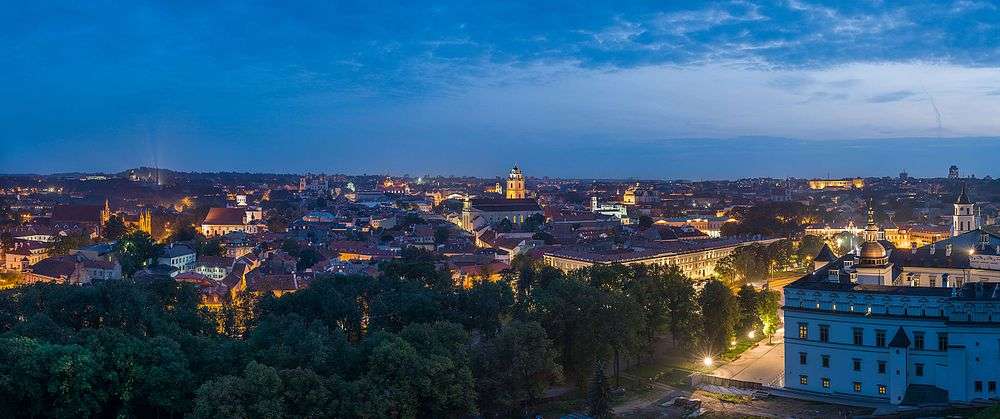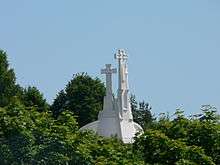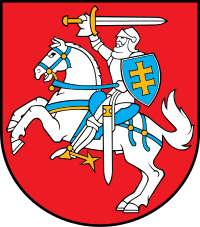Vilnius
Vilnius (Lithuanian pronunciation: [ˈvʲɪlʲnʲʊs] (![]()
Vilnius | |
|---|---|
.png) Clockwise from top right: Gediminas' Tower, Vilnius business district, Presidential Palace, Pilies Street, Gate of Dawn, Vilnius Cathedral and its bell tower | |
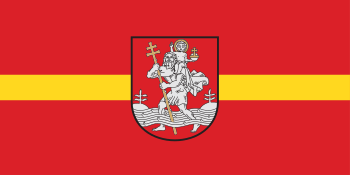 Flag | |
| Nickname(s): | |
| Motto(s): Unitas, Justitia, Spes (Latin: Unity, Justice, Hope) | |

Interactive map of Vilnius | |
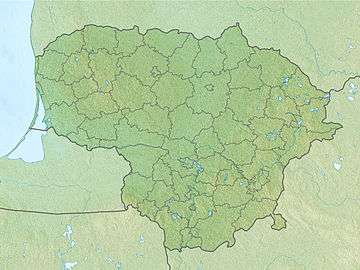 Vilnius Location within Lithuania 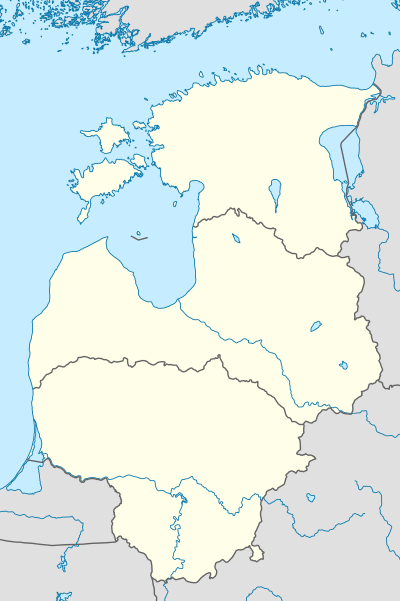 Vilnius Location within the Baltics  Vilnius Location within Europe | |
| Coordinates: 54°41′N 25°17′E | |
| Country | Lithuania |
| County | Vilnius County |
| Municipality | Vilnius City Municipality |
| Capital of | Lithuania |
| First mentioned | 1323 |
| Granted city rights | 1387 |
| Elderships | |
| Government | |
| • Type | City council |
| • Mayor | Remigijus Šimašius |
| Area | |
| • Capital city | 401 km2 (155 sq mi) |
| • Metro | 9,731 km2 (3,757 sq mi) |
| Elevation | 112 m (367 ft) |
| Population (2020)[6] | |
| • Capital city | 580,020 |
| • Rank | (52nd in EU) |
| • Density | 1,392/km2 (3,610/sq mi) |
| • Urban | 700,725[7] |
| • Metro | 810,290[8] |
| • Metro density | 83/km2 (210/sq mi) |
| Demonym(s) | Vilnian |
| Time zone | UTC+2 (EET) |
| • Summer (DST) | UTC+3 (EEST) |
| Postal code | 01001–14191 |
| Area code(s) | (+370) 5 |
| GRP (nominal) (metro)[9] | 2018 |
| – Total | €19 billion ($22B) |
| – Per capita | €23,400 ($27607) |
| HDI (2018) | 0.907[10] – very high |
| Website | vilnius |
| Official name | Historic Centre of Vilnius |
| Type | Cultural |
| Criteria | ii, iv |
| Designated | 1994 (18th session) |
| Reference no. | |
| UNESCO region | Europe |
Vilnius is classified as a Gamma global city according to GaWC studies, and is known for the architecture in its Old Town, declared a UNESCO World Heritage Site in 1994.[13] Before World War II, Vilnius was one of the largest Jewish centres in Europe. Its Jewish influence has led to its nickname "the Jerusalem of Lithuania". Napoleon called it "the Jerusalem of the North"[14] as he was passing through in 1812. In 2009, Vilnius was the European Capital of Culture, together with Linz, Austria.[15]
Etymology and other names
The name of the city originates from the Vilnia River, from the Lithuanian for ripple.[16] The city has also had many derivative spellings in various languages throughout its history: Vilna was once common in English. The most notable non-Lithuanian names for the city include Polish: Wilno, Belarusian: Вiльня (Vilnya), German: Wilna, Latvian: Viļņa, Ukrainian: Вільно (Vilno), Yiddish: ווילנע (Vilne). A Russian name from the time of the Russian Empire was Вильна (Vilna),[17][18] although Вильнюс (Vilnyus) is now used. The names Wilno, Wilna and Vilna were also used in older English, German, French and Italian language publications when the city was one of the capitals of the Polish–Lithuanian Commonwealth and an important city in the Second Polish Republic. The name Vilna is still used in Finnish, Portuguese, Spanish, and Hebrew. Wilna is still used in German, along with Vilnius.
The neighborhoods of Vilnius also have names in other languages, which represent the languages spoken by various ethnic groups in the area.
According to legend, Grand Duke Gediminas (c. 1275–1341) was hunting in the sacred forest near the Valley of Šventaragis, near where Vilnia River flows into the Neris River. Tired after the successful hunt of a wisent, the Grand Duke settled in for the night. He fell soundly asleep and dreamed of a huge Iron Wolf standing on top a hill and howling as strong and loud as a hundred wolves. Upon awakening, the Duke asked the krivis (pagan priest) Lizdeika to interpret the dream. The priest told him, "What is destined for the ruler and the State of Lithuania, is thus: the Iron Wolf represents a castle and a city which will be established by you on this site. This city will be the capital of the Lithuanian lands and the dwelling of their rulers, and the glory of their deeds shall echo throughout the world." Therefore, Gediminas, obeying the will of the gods, built the city, and gave it the name Vilnius, from the Vilnia River.[19]
History
Early history and Grand Duchy of Lithuania
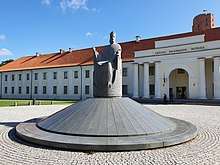
Historian Romas Batūra identifies the city with Voruta, one of the castles of Mindaugas, crowned in 1253 as King of Lithuania. During the reign of Grand Dukes Butvydas and Vytenis a city started to emerge from a trading settlement and the first Franciscan Catholic church was built.[20]
Vilnius is a historic and a present-day capital of Lithuania. Archeological findings indicate that this city was the capital of Lithuanian kingdom and later remained the capital of Lithuanian Grand Duchy continuously. Also later when Lithuania formed a dual confederation with Poland, Vilnius remained the capital of Lithuania.[21]
The city was first mentioned in written sources in 1323 as Vilna,[22] when the Letters of Grand Duke Gediminas were sent to German cities inviting Germans (including German Jews) to settle in the capital city, as well as to Pope John XXII. These letters contain the first unambiguous reference to Vilnius as the capital;[21] Old Trakai Castle had been the earlier seat of the court of the Grand Duchy of Lithuania.
The location of Vilnius offered practical advantages: it lay in the Lithuanian heartland at the confluence of two navigable rivers, surrounded by forests and wetlands that were difficult to penetrate. The duchy was continuously invaded by the Teutonic Knights.[24] The future King of England Henry IV (then Henry Bolingbroke) spent a full year of 1390 supporting the unsuccessful siege of Vilnius by Teutonic Knights with his 300 fellow knights. During this campaign he bought captured Lithuanian women and children and took them back to Königsberg to be converted.[25] King Henry's second expedition to Lithuania in 1392 illustrates the financial benefits to the Order of these guest crusaders. His small army consisted of over 100 men, including longbow archers and six minstrels, at a total cost to the Lancastrian purse of £4,360. Despite the efforts of Bolingbroke and his English crusaders, two years of attacks on Vilnius proved fruitless.[26]
Vilnius was the flourishing capital of the Grand Duchy of Lithuania, the residence of the Grand Duke. Gediminas expanded the Grand Duchy through warfare along with strategic alliances and marriages.[21] At its height it covered the territory of modern-day Lithuania, Belarus, Ukraine, Transnistria, and portions of modern-day Poland and Russia. His grandchildren Vytautas the Great and Jogaila, however, fought civil wars. During the Lithuanian Civil War of 1389–1392, Vytautas besieged and razed the city in an attempt to wrest control from Jogaila.[21] The two Gediminids cousins later settled their differences; after a series of treaties culminating in the 1569 Union of Lublin, the Polish–Lithuanian Commonwealth was formed. The rulers of this federation held either or both of two titles: Grand Duke of Lithuania or King of Poland. In 1387, Jogaila acting as a Grand Duke of Lithuania and King of Poland Władysław II Jagiełło, granted Magdeburg rights to the city.[21]
Polish–Lithuanian Commonwealth
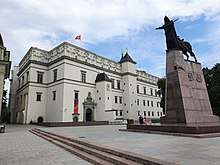
The city underwent a period of expansion. The Vilnius city walls were built for protection between 1503 and 1522, comprising nine city gates and three towers,[21] and Sigismund August moved his court there in 1544.
Its growth was due in part to the establishment of Alma Academia et Universitas Vilnensis Societatis Iesu by the Polish King and Grand Duke of Lithuania Stefan Bathory in 1579. The university soon developed into one of the most important scientific and cultural centres of the region and the most notable scientific centre of the Commonwealth.[27]
During its rapid development, the city was open to migrants from the territories of the Crown of the Kingdom of Poland, Grand Duchy and further. A variety of languages were spoken: Polish, German, Yiddish, Ruthenian, Lithuanian, Russian, Old Church Slavonic, Latin, Hebrew, and Turkic languages; the city was compared to Babylon.[24] Each group made its unique contribution to the life of the city, and crafts, trade, and science prospered.
The 17th century brought a number of setbacks. The Commonwealth was involved in a series of wars, collectively known as The Deluge. During the Russo-Polish War (1654–1667), Vilnius was occupied by Russian forces; it was pillaged and burned, and its population was massacred. During the Great Northern War it was looted by the Swedish army. An outbreak of bubonic plague in 1710 killed about 35,000 residents; devastating fires occurred in 1715, 1737, 1741, 1748, and 1749.[24] The city's growth lost its momentum for many years, but even despite this fact, at the end of the 18th century and before the Napoleon wars, Vilnius, with 56,000 inhabitants, entered the Russian Empire as its 3rd largest city.
In the Russian Empire
.jpg)
The fortunes of the Commonwealth declined during the 18th century. Three partitions took place, dividing its territory among the Russian Empire, the Habsburg Empire, and the Kingdom of Prussia. Forces led by Jakub Jasiński expelled Russians from Vilnius during the uprising in 1794.[28] Although, after the third partition of April 1795, Vilnius was annexed by the Russian Empire and became the capital of the Vilna Governorate. During Russian rule, the city walls were destroyed, and by 1805 only the Gate of Dawn remained. In 1812, the city was taken by Napoleon on his push towards Moscow, and again during the disastrous retreat. The Grande Armée was welcomed in Vilnius. Thousands of soldiers died in the city during the eventual retreat; the mass graves were uncovered in 2002.[24] Inhabitants expected Tsar Alexander I to grant them autonomy in response to Napoleon's promises to restore the Commonwealth, but Vilnius did not become autonomous, neither by itself nor as a part of Congress Poland.
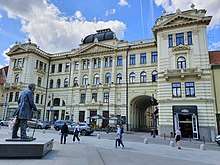
Following the November uprising in 1831, Vilnius University was closed and Russian repressions halted the further development of the city. Civil unrest in 1861 was suppressed by the Imperial Russian Army.[29]
During the January uprising in 1863, heavy fighting occurred within the city, but was brutally pacified by Mikhail Muravyov, nicknamed The Hangman by the population because of the number of executions he organized. After the uprising, all civil liberties were withdrawn, and use of the Polish[30] and Lithuanian languages was banned.[31] Vilnius had a vibrant Jewish population: according to Russian census of 1897, out of the total population of 154,500, Jews constituted 64,000 (approximately 40%).[32] During the early 20th century, the Lithuanian-speaking population of Vilnius constituted only a small minority, with Polish, Yiddish, and Russian speakers comprising the majority of the city's population.[33]
On 4–5 December 1905, the Great Seimas of Vilnius was held in the current Lithuanian National Philharmonic Society building with over 2000 participants. It was the first modern national congress in Lithuania.[34] The assembly made the decision to demand wide political autonomy within the Russian Empire and achieve this by peaceful means. It is considered an important step towards the Act of Independence of Lithuania, adopted on 16 February 1918 by the Council of Lithuania, as the Seimas laid the groundwork for the establishment of an independent Lithuanian state.[35]
In Poland
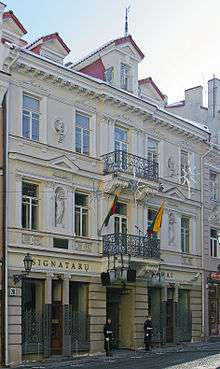
During World War I, Vilnius and the rest of Lithuania was occupied by the German Army from 1915 until 1918.[36] The Act of Independence of Lithuania, declaring Lithuanian independence from any affiliation to any other nation, was issued in the city on 16 February 1918 with Vilnius as its capital.[37] At the end of 1918 Soviet Russia invaded Lithuania with massive forces, and the Lithuanian Army withdrew from Vilnius to the center of the country in order to form a defense line. The German Army withdrew together with a Lithuanian government. Thus the city was briefly controlled by Polish self-defence units, to protect the city from the invaders, who were driven out by advancing Soviet forces. Vilnius changed hands again during the Polish–Soviet War and the Lithuanian Wars of Independence: it was taken by the Polish Army, only to fall to Soviet forces again. Shortly after its defeat in the 1920 Battle of Warsaw, the retreating Red Army, in order to delay the Polish advance, ceded the city to Lithuania after signing the Soviet–Lithuanian Peace Treaty on 12 July 1920.[38]
The League of Nations became involved in the subsequent Lithuanian self defense from Poland after it attacked Lithuanian army positions in the south west part of Lithuania. The League brokered the ceasefire called the Suwałki Agreement on 7 October 1920. Lithuanians believed that it stopped a Polish aggression. Although neither Vilnius or the surrounding region was explicitly addressed in the agreement, numerous historians have described the agreement as allotting Vilnius to Lithuania.[40][41][42][43][44][45][46][47][48] On 9 October 1920, the Polish Army surreptitiously, under General Lucjan Żeligowski, seized Vilnius during an operation known as Żeligowski's Mutiny. The city and its surroundings were designated as a separate state, called the Republic of Central Lithuania. On 20 February 1922 after the highly contested election in Central Lithuania, the entire area was annexed by Poland, with the city becoming the capital of the Wilno Voivodship (Wilno being the name of Vilnius in Polish). Kaunas then became the temporary capital of Lithuania. Lithuania vigorously contested the Polish annexation of Vilnius, and refused diplomatic relations with Poland. The predominant languages of the city were still Polish and, to a lesser extent, Yiddish. The Lithuanian-speaking population at the time was a small minority, at about 6% of the city's population according even to contemporary Lithuanian sources.[49] The Council of Ambassadors and the international community (with the exception of Lithuania) recognized Polish sovereignty over Vilnius Region in 1923.[50]
Vilnius University was reopened in 1919 under the name of Stefan Batory University.[51] By 1931, the city had 195,000 inhabitants, making it the fifth largest city in Poland with varied industries, such as Elektrit, a factory that produced radio receivers.
Nazi Germany had invited Lithuania to join the Invasion of Poland and retake the historical capital Vilnius by force; however, President Antanas Smetona and most of the Lithuanian politicians declined this offer because they had doubts about Adolf Hitler's eventual victory and were outraged by the 1939 German ultimatum to Lithuania. Instead, they supported the neutrality policy and after being encouraged by the French and British diplomats – Lithuania had adopted the Neutrality Act, which was supported by all the political forces.[52]
World War II
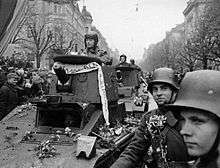
World War II began with the German invasion of Poland in September 1939. The secret protocols of the Molotov–Ribbentrop Pact had partitioned Lithuania and Poland into German and Soviet spheres of interest. On 19 September 1939, Vilnius was seized by the Soviet Union (which invaded Poland on 17 September). The Soviets repressed the local population and devastated city, moving values and factories to the USSR territory, including the major Polish radio factory Elektrit, along with a part of its labour force, to Minsk in Belarus SSR.[53] The Soviets and Lithuania concluded a mutual assistance treaty on 10 October 1939, with which the Lithuanian government accepted the presence of Soviet military bases in various parts of the country. On 28 October 1939, the Red Army withdrew from the city to its suburbs (to Naujoji Vilnia) and Vilnius was given over to Lithuania. A Lithuanian Army parade took place on 29 October 1939 through the city centre. The Lithuanians immediately attempted to Lithuanize the city, for example by Lithuanizing Polish schools.[54]
Just after the beginning of the World War II, on 2 September 1939, the Lithuanian Consulate was opened in Vilnius. The consulate was the first in the world to grant Visas For Life for the Jews and also saved many Polish war refugees.[55]
The whole of Lithuania was annexed by the Soviet Union on 3 August 1940 following a June ultimatum from the Soviets demanding, among other things, that unspecified numbers of Red Army soldiers be allowed to enter the country for the purpose of helping to form a more pro-Soviet government. After the ultimatum was issued and Lithuania further occupied, a Soviet government was installed with Vilnius as the capital of the newly created Lithuanian SSR. Between 20,000 and 30,000 of the city's inhabitants were subsequently arrested by the NKVD and sent to gulags in the far eastern areas of the Soviet Union.[56]
.jpg)
On 22 June 1941, the Germans launched Operation Barbarossa against the Soviet Union, while at the same time Lithuanians began the anti-Soviet June Uprising, organized by the Lithuanian Activist Front. Lithuanians proclaimed independence and organized the Provisional Government of Lithuania. This government quickly self-disbanded.[57] Nazis captured Vilnius on 24 June 1941.[58] Lithuania became part of the Reichskommissariat Ostland, German civil administration.[59] Two ghettos were set up in the old town centre for the large Jewish population – the smaller one of which was "liquidated" by October.[60] The larger ghetto lasted until 1943, though its population was regularly deported in roundups known as "Aktionen".[61] A forced labour camp (Kailis) was also set up behind the Vilnius Town Hall as a factory to produce winter clothing for the Wehrmacht and another one later for vehicle repair (HKP 562) on 47 & 49 Subačiaus Street. A failed ghetto uprising on 1 September 1943 organized by the Fareinigte Partizaner Organizacje (the United Partisan Organization, the first Jewish partisan unit in German-occupied Europe),[62] was followed by the final destruction of the ghetto. During the Holocaust, about 95% of the 265,000-strong Jewish population of Lithuania was murdered by the German units and Lithuanian Nazi collaborators, many of them in Paneriai, about 10 km (6.2 mi) west of the old town centre (see the Ponary massacre).
In 1944, after the Nazis suffered losses in the Eastern Front and the Red Army was approaching, the Lithuanian Territorial Defense Force (LTDF) was established under the command of general Povilas Plechavičius. The LTDF mission was to defend the country within its borders against the Red Army and the Soviet partisans.[63] On 1 April 1944, the LTDF battalions entered Vilnius and confronted the Armia Krajowa (AK), which attempted to capture the city before the Soviets (see Operation Ostra Brama).[64] The AK tried to negotiate a non-aggression pact with Plechavičius, but the Lithuanian side demanded the Poles to abandon the Vilnius Region or subordinate themselves to Lithuanians.[65] The 19 500 men LTDF disbanded itself after refusing to transcend the Lithuanian border and to aid the Nazis in the Eastern Front. Many of the former LTDF members later formed the core of the Lithuanian partisans (e.g. Jonas Žemaitis).[66]
In the Lithuanian SSR (Soviet Union)
In July 1944, Vilnius was captured from the Germans by the Soviet Army (see Vilnius Offensive) and the town was once again incorporated into the Soviet Union as the capital of the Lithuanian SSR.[67] The NKVD began repressions against the leaders of the Armia Krajowa and Lithuanians.[68][69]
The war had irreversibly altered the town – most of the predominantly Polish and Jewish population had been repatriated and exterminated respectively, during and after the German occupation. Some members of the intelligentsia and partisan members hiding in the forest were now targeted and deported to Siberia after the war. The majority of the remaining population was compelled to move to Communist Poland by 1946, and Sovietization began in earnest.
From the late 1940s on Vilnius began to grow again, following an influx of Lithuanians, Poles and Belarusians from neighbouring regions within Lithuania as well as neighbouring region of Grodno and from other more remote areas of the Soviet Union (particularly Russia, Belarus and Ukraine). On the previously rural outskirts as well as in the very vicinity of the Old town (industrial zones in Paupys, Markučiai, Naujamiestis), industrial areas were designed and large Soviet plants were built, following a program of industrialization.
In November 1980 the number of inhabitants of Vilnius exceeded 500,000. Because of shortage of housing for a growing population of the city, large scale Microdistricts (so-called sleeping districts) were built in the elderates of Antakalnis, Žirmūnai, Lazdynai, Karoliniškės, Viršuliškės, Baltupiai, Justiniškės, Pašilaičiai, Fabijoniškės and on a smaller scale in other parts of Vilnius.[21] These were connected with the central part as well as with industrial areas via expressway-like streets (so-called fast traffic streets) and by public transport, noticeably extensive network of trolleybuses (from 1956).
Independent Lithuania
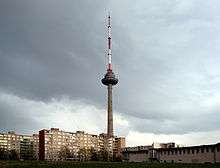
On 11 March 1990, the Supreme Council of the Lithuanian SSR announced its secession from the Soviet Union and intention to restore an independent Republic of Lithuania.[70] As a result of these declarations, on 9 January 1991, the Soviet Union sent in troops. This culminated in the 13 January attack on the State Radio and Television Building and the Vilnius TV Tower, killing at least fourteen civilians and seriously injuring 700 more.[71] The Soviet Union finally recognised Lithuanian independence in September 1991.[72] The Constitution, as did the earlier Lithuanian Constitution of 1922, mentions that "the capital of the State of Lithuania shall be the city of Vilnius, the long-standing historical capital of Lithuania".

Vilnius has been rapidly transforming, emerging as a modern European city. The majority of its historical buildings during the last 25 years had been renovated, and a business and commercial area is being developed into the New City Centre, that is expected to become the city's main administrative and business district on the north side of the Neris river. This area includes modern residential and retail space, with the municipality building and the 148.3-metre (487 ft) Europa Tower as its most prominent buildings. The construction of Swedbank's headquarters is symbolic of the importance of Scandinavian banks in Vilnius. The building complex Vilnius Business Harbour was built in 2008, and one of its towers is now the 6th tallest building in Lithuania. More buildings are scheduled for construction in the area. More than 75,000 new flats were built between 1995 and 2018 (including almost 50,000 new flats between 2003 and 2018), making Vilnius an absolute leader in construction sector in the Baltics of the last two decades. On average, 298,000-square-metre (3,210,000 sq ft) or 3,246 flats are built each year. In 2015, there were 225,871 units in Multi-family residentials and 20,578 flats in single-family or duplex apartment houses, the share of such housing increasing from 6.9% in 2006 to 8.3% in 2015.[73][74][75]
Vilnius was selected as a 2009 European Capital of Culture, along with Linz, the capital of Upper Austria. Its 2009 New Year's Eve celebration, marking the event, featured a light show said to be "visible from outer space".[76] In preparation, the historical centre of the city was restored, and its main monuments were renovated.[77]
The global economic crisis led to a drop in tourism which prevented many of the projects from reaching their planned extent, and allegations of corruption and incompetence were made against the organisers,[78][79] while tax increases for cultural activity led to public protests[80] and the general economic conditions sparked riots.[81] In 2015 Remigijus Šimašius became the first directly elected mayor of the city.[82]
On 28–29 November 2013, Vilnius hosted the Eastern Partnership Summit in the Palace of the Grand Dukes of Lithuania. Many European presidents, prime ministers and other high-ranking officials participated in the event.[83] On 29 November 2013, Georgia and Moldova signed association and free trade agreements with the European Union.[84] Previously, Ukraine and Armenia were also expected to sign the agreements but postponed the decision, sparking large protests in Ukraine.
Geography
.jpg)
Vilnius is situated in south-eastern Lithuania (54°41′N 25°17′E) at the confluence of the Vilnia and Neris Rivers.
Multiple countries claims that the Geographical Centre of Europe is located in their territories, however the only location with recognition in the Guinness Book of World Records is located near Vilnius.[85] After a re-estimation of the boundaries of the continent of Europe in 1989, Jean-George Affholder, a scientist at the Institut Géographique National (French National Geographic Institute) determined that the geographic centre of Europe is located at 54°54′N 25°19′E.[86] The method used for calculating this point was that of the centre of gravity of the geometrical figure of Europe. This point is located in Lithuania, near the village of Girija (26 kilometres from Vilnius). A monument, composed by the sculptor Gediminas Jokūbonis and consisting of a column of white granite surmounted by a crown of stars, was erected at the location in 2004.[85]
Vilnius lies 312 km (194 mi) from the Baltic Sea and Klaipėda, the chief Lithuanian seaport. Vilnius is connected by highways to other major Lithuanian cities, such as Kaunas (102 km or 63 mi away), Šiauliai (214 km or 133 mi away) and Panevėžys (135 km or 84 mi away).
The area of Vilnius is 402 square kilometres (155 sq mi). Buildings occupy 29.1% of the city; green spaces occupy 68.8%; and waters occupy 2.1%.[87]
Nature reserves
Vilnius has eight protected nature reserves: Vokės Senslėnio Slopes Geomorphological Reserve, Aukštagiris Geomorphological Reserve, Valakupių Klonio Geomorphological Reserve, Veržuva Hydrographic Reserve, Vokė Hydrographic Reserve, Cedronas Upstream Landscape Reserve, Tapeliai Landscape Reserve and Šeškinė Slopes Geomorphological Reserve.[88]
Climate
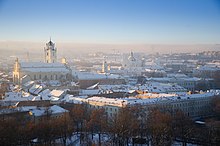
The climate of Vilnius is humid continental (Köppen climate classification Dfb).[89] Temperature records have been kept since 1777.[90] The average annual temperature is 6.7 °C (44 °F); in January the average temperature is −4.3 °C (24 °F), in July it is 18.1 °C (65 °F). The average precipitation is about 682 millimetres (26.85 in) per year. Average annual temperatures in the city have increased significantly during the last 30 years, a change which the Lithuanian Hydrometeorological Service attributes to global warming induced by human activities.[91]
Summer days are pleasantly warm and sometimes hot, especially in July and August, with temperatures above 30 °C (86 °F) throughout the day during periodic heat waves. Night-life in Vilnius is in full swing at this time of year, and outdoor bars, restaurants and cafés become very popular during the daytime.
Winters can be very cold, with temperatures rarely reaching above freezing – temperatures below −25 °C (−13 °F) are not unheard-of in January and February. Vilnius's rivers freeze over in particularly cold winters, and the lakes surrounding the city are almost always permanently frozen during this time of year. A popular pastime is ice-fishing.
The Lithuanian Hydrometeorological Service is headquartered in Vilnius and monitors climate of Vilnius and Lithuania.[92]
| Climate data for Vilnius (1981–2010 normals, sun 1961–1990) | |||||||||||||
|---|---|---|---|---|---|---|---|---|---|---|---|---|---|
| Month | Jan | Feb | Mar | Apr | May | Jun | Jul | Aug | Sep | Oct | Nov | Dec | Year |
| Record high °C (°F) | 11.0 (51.8) |
14.4 (57.9) |
19.8 (67.6) |
29.0 (84.2) |
31.8 (89.2) |
34.2 (93.6) |
36.4 (97.5) |
34.9 (94.8) |
33.1 (91.6) |
24.5 (76.1) |
15.5 (59.9) |
10.5 (50.9) |
36.4 (97.5) |
| Average high °C (°F) | −1.9 (28.6) |
−1.2 (29.8) |
3.8 (38.8) |
12.0 (53.6) |
18.4 (65.1) |
20.8 (69.4) |
23.2 (73.8) |
22.4 (72.3) |
16.6 (61.9) |
10.2 (50.4) |
3.2 (37.8) |
−0.8 (30.6) |
10.6 (51.1) |
| Daily mean °C (°F) | −4.3 (24.3) |
−4 (25) |
0.2 (32.4) |
7.1 (44.8) |
12.9 (55.2) |
15.7 (60.3) |
18.1 (64.6) |
17.3 (63.1) |
12.3 (54.1) |
6.9 (44.4) |
1.1 (34.0) |
−3 (27) |
6.7 (44.1) |
| Average low °C (°F) | −6.6 (20.1) |
−6.8 (19.8) |
−3.4 (25.9) |
2.1 (35.8) |
7.3 (45.1) |
10.6 (51.1) |
13.0 (55.4) |
12.1 (53.8) |
7.9 (46.2) |
3.6 (38.5) |
−1.1 (30.0) |
−5.2 (22.6) |
2.4 (36.3) |
| Record low °C (°F) | −37.2 (−35.0) |
−35.8 (−32.4) |
−29.6 (−21.3) |
−14.4 (6.1) |
−4.4 (24.1) |
0.1 (32.2) |
3.5 (38.3) |
1.0 (33.8) |
−4.8 (23.4) |
−14.4 (6.1) |
−22.8 (−9.0) |
−30.5 (−22.9) |
−37.2 (−35.0) |
| Average precipitation mm (inches) | 48.7 (1.92) |
38.2 (1.50) |
42.1 (1.66) |
41.6 (1.64) |
56.3 (2.22) |
78.6 (3.09) |
86.3 (3.40) |
72.3 (2.85) |
63.3 (2.49) |
54.7 (2.15) |
47.7 (1.88) |
52.6 (2.07) |
682.3 (26.86) |
| Average precipitation days | 12.4 | 10.5 | 9.6 | 8.6 | 9.6 | 11.4 | 10.7 | 9.6 | 9.6 | 10.1 | 10.4 | 12.2 | 124.8 |
| Mean monthly sunshine hours | 36 | 71 | 117 | 164 | 241 | 231 | 219 | 217 | 140 | 94 | 33 | 25 | 1,588 |
| Average ultraviolet index | 0 | 1 | 2 | 3 | 5 | 6 | 6 | 5 | 3 | 2 | 1 | 0 | 3 |
| Source: WMO (avg high and low)[93] NOAA (sun, extremes, and mean temperatures)[94], Météo Climat[95] and Weather Atlas[96] | |||||||||||||
Culture
Painting and sculpture
.jpg)
For centuries, Vilnius as a capital city was an art centre of the Grand Duchy of Lithuania and has attracted artists from all across Europe. The oldest works of art which remained from the early Gothic period (14th century) are paintings dedicated to churches and liturgy (e.g. frescoes in the Crypts of Vilnius Cathedral, decorated hymns books). Walls paintings from the 16th centuries were also discovered in Vilnius (e.g. painting of the Church of St. Francis and St. Bernard vaults or in the Church of Saint Nicholas).[97] Gothic wooden, mostly polychrome sculptures were used to decorate the altars of the churches of Vilnius. Some Gothic seals from the 14–15th centuries remained till the nowadays (Kęstutis, Vytautas the Great, Sigismund II Augustus).[98]
In the early 16th century, the Renaissance sculptures appeared, which were mostly created by Italian sculptors: Bernardinus Zanobi da Gianotti, Giovani Cini, Giovanni Maria Padovano. In the Renaissance period, portrait tombstones and medals were highly valued (e.g. marle tomb of Albertas Goštautas, 1548, by B. Z. da Gianotti, tomb of Povilas Alšėniškis, 1555, by G. Cini, both located in the Vilnius Cathedral). The works of Italian sculptors are characterized by a naturalistic treatment of forms, precise proportions, tectonicity, a realistic representation of the deceased. The local sculptors took over only the iconographic scheme of the Renaissance tomb; their works (e.g. tomb of Lew Sapieha, ca. 1633, at Church of St. Michael) are characterized by conditionality of forms, stylization.[98] During this period local and Western European painters created religious, mythologic compositions, portraits, which were intertwined with late Gothic and Baroque features. Illustrated prayer books illustrations and miniatures have survived.[97]
The Baroque period which began in the late 16th century was exceptional for Vilnius as wall painting blossomed in the city. Most of the palaces and churches were decorated with frescoes characterized by bright colors, sophisticated angles and dramatism style. Also during this period the secular painting spread – representational, imaginative, epitaph portraits, scenes of battles, politically important events. It is characterized by detailed realistic style.[97] This period sculptures dominated in the sacred architecture (tombstones with sculptural portraits, exterior and interior decorative sculptures), made of wood, marble and stucco. Italian sculptors (e.g. G. P. Perti, G. M. Galli, A. S. Capone) were exceptionally important in the 17th century Grand Duchy's sculptures development and were invited there by the Lithuanian nobility. Their works are characterized by the features of mature baroque: expressiveness of forms, sensuality, atectonic composition (e.g. sculptural decor of the Church of St. Peter and St. Paul). The local sculptors emphasized the decorative features of the baroque, and the expressiveness and emotionality of the baroque was less characteristic in their works.[98]

At the late 18th and 19th centuries, the Lithuanian painting was largely influenced by the Vilnius Art School which introduced manifestations of Classicism art and later of Romanticism art. The painters had internships abroad, mainly in Italy. Painting of allegorical, mythological compositions, landscapes, portraits of representatives of various circles of society was begun; historical themes prevailed. The most famous Classicism painters from this time are Pranciškus Smuglevičius, Jan Rustem, Juozapas Oleškevičius, Danielius Kondratavičius, Juozapas Peška, Vincentas Smakauskas. While the Romanticism art is characterized by Jan Rustem, Jonas Damelis, Vincentas Dmachauskas, Kanutas Ruseckas works.[97] After the closure of Vilnius University in 1832, the artistic direction formed by the representatives of the Vilnius Art School influenced the further development of Lithuanian art.[99]
Development of art in the first half of the 20th century was promoted by activities and exhibitions of the Lithuanian Art Society, established in 1907 by Petras Rimša, Antanas Žmuidzinavičius, Antanas Jaroševičius, and Vilnius Art Society, established in 1908.[100][101] This period is characterized by Jonas Šileika, Justinas Vienožinskis, Jonas Mackevičius, Vytautas Kairiūkštis, Vytautas Pranas Bičiūnas works. They continued the traditions of Western European styles (symbolism, realism, art nouveau) and followed the modernism art directions.[97] Although, after the World War II the method of socialist realism was introduced – propaganda paintings, compositions of historical, household genre, still lifes, landscapes, portraits and sculptures.[97][98]
The most notable late 20th and 21st centuries Vilnian painters are Žygimantas Augustinas, Eglė Ridikaitė, Eglė Gineitytė, Patricija Jurkšaitytė, Jurga Barilaitė, Solomonas Teitelbaumas.[97]
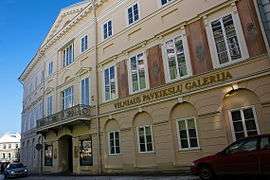
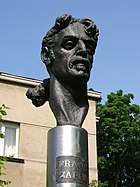
Many prominent art galleries are located in Vilnius. Lithuania's largest art collection is housed in the Lithuanian Art Museum.[102] One branch of it, the Vilnius Picture Gallery in the Old Town, houses a collection of Lithuanian art from the 16th to the beginning of the 20th century.[103] On the other side of the Neris, the National Art Gallery holds a permanent exhibition on Lithuanian 20th-century art, as well as numerous exhibitions on modern art.[104] The Contemporary Art Centre is the largest venue for contemporary art in the Baltic States, with an exhibition space of 2400 square meters. The centre is a non-collection based institution committed to developing a broad range of international and Lithuanian exhibition projects as well as presenting a wide range of public programmes including lectures, seminars, performances, film and video screenings, and live new music events.[105] On 10 November 2007, the Jonas Mekas Visual Arts Center was opened by avant-garde filmmaker Jonas Mekas with its premiere exhibition entitled The Avant-Garde: From Futurism to Fluxus.[106] In 2018, the MO Museum was opened and is a personal initiative of Lithuanian scientists and philanthropists Danguolė and Viktoras Butkus. Its collection of 5000 modern and contemporary pieces contains major Lithuanian artworks from the 1950s to this day.[107]
The Užupis district near the Old Town, which used to be one of the more run-down districts of Vilnius during the Soviet era, is home to a movement of bohemian artists, who operate numerous art galleries and workshops. Užupis declared itself an independent republic on April Fool's Day in 1997.[108] In the main square, the statue of an angel blowing a trumpet stands as a symbol of artistic freedom.
In 1995, the world's first bronze cast of Frank Zappa[109] was installed in the Naujamiestis district with the permission of the government. The Frank Zappa sculpture confirmed the newly found freedom of expression and marked the beginning of a new era for Lithuanian society.
In 2015, the project of Vilnius Talking Statues was realized. Eighteen statues around Vilnius interact with visitors in multiple languages by a telephone call to a smartphone.[110]
Literature

About 1520, Francysk Skaryna, who is the author of the first Ruthenian Bible, established a printing house in Vilnius – the first in Eastern Europe. In 1522, he prepared and published the first printed book of the Grand Duchy of Lithuania, titled the Little Traveller's Book (Ruthenian language: Малая подорожная книжка). In 1525 he printed the Acts and Epistles of the Apostles (the Apostle).[111]
The Vilnius Academy Press was established in 1575 by the Lithuanian noble Mikołaj Krzysztof "the Orphan" Radziwiłł as the printing house of the Vilnius Academy. He delegated the management of the printing house to the Jesuits. In May 1576, it published its first book Pro Sacratissima Eucharistia contra haeresim Zwinglianam by Piotr Skarga. The Vilnius Academy Press situation was exceptional because its activities were funded by the secular society, the Lithuanian nobility and the Church.[112] In 1805, Józef Zawadzki bought the Vilnius Academy Press and founded the Józef Zawadzki printing shop which continuously worked till 1939 and published books in multiple languages.[113] The first poetry book of Adam Mickiewicz was published there in 1822.[114]
.jpg)
One of the creators of Lithuanian writing, Mikalojus Daukša, translated and published the Catechism by Spanish Jesuit theologist Jacobo Ledesma in 1595 – this was the first printed Lithuanian language book in the Grand Duchy of Lithuania. He also translated and published the Jakub Wujek's Postilla Catholica in 1599 (both in Vilnius).[115]

Many famous writers were born, lived in Vilnius or are alumnus of the Vilnius University (e.g. Konstantinas Sirvydas, Maciej Kazimierz Sarbiewski, Antoni Gorecki, Józef Ignacy Kraszewski, Antoni Edward Odyniec, Michał Józef Römer, Adam Mickiewicz, Władysław Syrokomla, Józef Mackiewicz, Romain Gary, Juliusz Słowacki, Simonas Daukantas, Mykolas Biržiška, Petras Cvirka (who was killed in Vilnius by soviet secret police), Kazys Bradūnas, Nobel prize-winner Czesław Miłosz, Jurga Ivanauskaitė).[116]
The first consideration of the First Statute of Lithuania took place in 1522 at the Seimas of the Grand Duchy of Lithuania in Vilnius. The Statute of Lithuania has been drafted under the guidance of Grand Chancellor of Lithuania Albertas Goštautas and in accordance with the courts' jurisprudence formed by customary law, Heads of State legislation on certain matters and by the provisions of the canon law and Roman law regulations. It is the first official codification of this kind of secular law in Europe.[117]
Lithuanian nationalist Albertas Goštautas actively supported the Lithuanian language usage in the Lithuanian literature and protected Lithuanian authors, including Abraomas Kulvietis and Michael the Lithuanian, who criticised the usage of Old Slavonic church language and called refugees Old Believers as the Muscovian spies in his book De moribus tartarorum, lituanorum et moscorum.[118]
Since the 16th century, the Lithuanian Metrica was kept at the Lower Castle and safeguarded by the State Chancellor. Due to the deterioration of the books, the State Grand Chancellor, Lew Sapieha, ordered the volumes of the Metrica to be recopied in 1594. The recopying process continued until 1607. The newly recopied books were inventoried, rechecked, and transferred to a separate building in Vilnius, with the older books remaining in the Castle of Vilnius. According to the 1983 data, 665 books have remained till the nowadays and their microfilms are preserved at the Lithuanian State Historical Archives in Vilnius.[119]
Over 200 tiles and commemorative plaques to writers, who have lived and worked in Vilnius, and foreign authors, who have shared a connection with Vilnius and Lithuania, adorn walls on Literatų Street (Lithuanian: Literatų gatvė) in the Old Town, presenting a broad overview of the history of Lithuanian literature.[120]
The Institute of Lithuanian Literature and Folklore and the Lithuanian Writers' Union are located in Vilnius.[121][122]
The biggest book fair in Baltic states is annually held in Vilnius at LITEXPO, the Baltic's biggest exhibition centre.[123]
Cinema
.jpg)
The very first public film session in Vilnius was held in the Botanical Garden (now Bernardinai Garden) in the summer of 1897. It is notable that such an event was held in Vilnius soon after the very first film sessions in the world by Auguste and Louis Lumière, who held it in Paris in 1895. Vilnius film session also showed the Lumière brothers documentary movies. Firstly shown movies were educational and were filmed in exotic locations (e.g. India, Africa) and introduced different cultures to Vilnians, who enjoyed the movies because very few were able to visit such far places. Georges Méliès's movie A Trip to the Moon was first shown in the non-stationary Lukiškės Square movie theater in 1902 and was the first feature film shown in Vilnius.[124]

First stationary movie theater in Vilnius named Iliuzija (English: Illusion) was opened in 1905 and was located in Didžioji Street 60.[125] First movie theaters reminded theatres buildings and had boxes with more expensive tickets. Also, because there was no sound in the first movies, the sessions had a live orchestral or musicians performances. On stage, cinema screening was sometimes mixed with theatrical performances, illusion shows.[124]
On 4 June 1924, Vilnius Magistrate established a popular 1,200-seat movie theater in the city hall, which in Polish was called Miejski kinematograf (English: City Movie Theater). The purpose of this cinema was to provide cultural education for students and adults. The popularity of this cinema is evidenced by the numbers of viewers in 1926: 502 261 tickets were sold, 24 242 tickets were given free to boarding children, 778 to Vilnius guests and 8385 to soldiers. In 1939, the Lithuanian authorities renamed it to Milda. In 1940, the last city government handed over the premises to the People's Commissariat of Education, which established a Lithuanian National Philharmonic Society there.[125]
In 1965, the most modern movie theater in Lithuania called Lietuva was opened in Vilnius, which annually had over 1.84 million visitors and profit of over 1 million Soviet rubles. After the reconstruction, it had one of the largest screens in Europe (200 square metres).[125] Though, it was closed in 2002, demolished in 2017 and the MO Museum was built instead of it.[126]
Vilnius Film Festival Kino Pavasaris is the biggest and most important cinema event in Lithuania with international guests and thousands of visitors.[127]
Lithuanian Film Centre (Lithuanian: Lietuvos kino centras), which main task is to promote the development and competitiveness of the Lithuanian film industry, headquarters are in Vilnius.[128]
Music
It is well known, that musicians were presented at Ducal court in Vilnius as early as the 14th century as various historical sources mention. In the 16th century Vilnius for some time in their lives was a hometown of composer Wacław of Szamotuły, lutenist virtuoso Bálint Bakfark, composer Jan Brant. The first textbook of music in Lithuania – The Art and Practice of Music (Latin: Ars et praxis musica) was issued in Vilnius by Žygimantas Liauksminas in 1667.[130]
Italian artists organized the first opera in Lithuania on 4 September 1636 at the Palace of the Grand Dukes by the order of Grand Duke Władysław IV Vasa.[131] Operas are staged at the Lithuanian National Opera and Ballet Theatre and also by independent troupe Vilnius City Opera.[132]
The Lithuanian National Philharmonic Society is the largest and oldest state owned concert organization in Lithuania, whose main activity is to organise and coordinate live concerts, diverse classical/classical contemporary/jazz music events and tours throughout Lithuania and abroad.[133] The Lithuanian State Symphony Orchestra, founded by Gintaras Rinkevičius, every year builds up a wide-ranging repertoire, introduces exceptional programs, and invites young talent to perform along with recognized soloists.[134]
In Lithuania, choral music is very important. Vilnius is the only city with three choirs laureates (Brevis, Jauna Muzika and Chamber Choir of the Conservatoire) at the European Grand Prix for Choral Singing.[135] There is a long-standing tradition of the Dainų šventė (Lithuanian Song and Dance Festival). Since 1990, the festival has been organised every four years and summons roughly 30,000 singers and folk dancers of various professional levels and age groups from across the country in Vingis Park.[136] In 2008, Lithuanian Song and Dance Festival together with its Latvian and Estonian versions was inscribed as UNESCO Masterpiece of the Oral and Intangible Heritage of Humanity.[137]
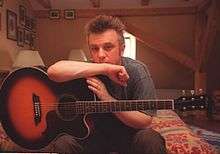
Jazz scene was active even during the years of Soviet occupation. The real breakthrough would occur in 1970–71 with the coming together of the Ganelin/Tarasov/Chekasin trio, the alleged instigators of the Vilnius Jazz School.[138] Most known annual event of jazz in the city is the Vilnius Jazz Festival.
Gatvės muzikos diena (Street Music Day) gathers musicians of various genres annually in the streets of Vilnius.[139]
Vilnius is the birthplace of many prominent music personalities: singers (e.g. Mariana Korvelytė – Moravskienė, Paulina Rivoli, Danielius Dolskis, Vytautas Kernagis, Algirdas Kaušpėdas, Andrius Mamontovas, Nomeda Kazlaus, Asmik Grigorian), composers (e.g. César Cui, Felix Yaniewicz, Maximilian Steinberg, Vytautas Miškinis, Onutė Narbutaitė), conductors (e.g. Mirga Gražinytė-Tyla), musicians (e.g. Antoni Radziwiłł, Jascha Heifetz, Clara Rockmore, Romas Lileikis).
Vilnius was a hometown of such 18th century composers as Michał Kazimierz Ogiński, Johann David Holland (colleague of C. Bach), Maciej Radziwiłł, Michał Kleofas Ogiński. 19th century Vilnius was famous for such European scale performers as singer Kristina Gerhardi Frank – a close friend of Mozart and Haydn (performed the main part at the premiere of The Creation by the latter), guitarist-virtuoso Marek Konrad Sokołowski, recognized as the best guitarist in Europe in the mid-19th century, composer Stanisław Moniuszko – "the father of Polish national opera". The wealthiest woman in the early 19th century Vilnius was singer Maria de Neri. In the early 20th century, Vilnius was a hometown of Mikalojus Konstantinas Čiurlionis. Musicians of late 20th and early 21st centuries include Vyacheslav Ganelin, Petras Vyšniauskas, Petras Geniušas, Mūza Rubackytė, Alanas Chošnau, Marijonas Mikutavičius.
Lithuanian Academy of Music and Theatre is headquartered in Gediminas Avenue and also has its department at the Slushko Palace in Antakalnis. Many accomplished singers lectured at the Academy, including internationally famous tenors Kipras Petrauskas and Virgilijus Noreika.[140]
Theatre
Lithuanian Grand Dukes' entertainment at the castle, ruler's visits abroad and the honorable guests' arrival meetings etiquette had theatrical elements already since the 14th century (e.g. musicians' chapels of Gediminas and Władysław II Jagiełło). During the period of Sigismund III Vasa's residence in Vilnius (first half of the 17th century), English professional drama actors' troupes played in the royal manor. In 1635, Władysław IV Vasa established a professional opera theatre in the Lower Castle, where dramma per musica genre productions were performed with operas' librettos being written by Italian Virgilio Puccitelli. The performances were characterized by fundamental, luxurious scenography.[141]
In 16–18th centuries there was a Jesuit's School Theatre in Lithuania. In 1570, the first performance was shown in Vilnius (comedy Hercules by S. Tucci). Baroque aesthetics prevailed in the Jesuit's School Theatre, but it also had Middle Ages retrospectives, Renaissance elements, Rococo motifs, and served an educational function. The performances were played in Latin, however elements of the Lithuanian language were also included in intermediates and prologues, and some of the works were Lithuanian themed (e.g. plays dedicated to Algirdas, Mindaugas, Vytautas and other rulers of Lithuania).[142][143]
In 1785, Wojciech Bogusławski established the city's first public theatre Vilnius City Theatre. The theatre was initially located in the Oskierka Palace, but later moved to the Radziwiłł Palace and the Vilnius Town Hall. Until 1845 the plays were performed in Polish, from 1845 in Polish and Russian and from 1864 only in Russian. After the ban on the Lithuanian language was lifted, the plays were also performed in Lithuanian. The theatre ceased to exist in 1914.[144]
During the interwar, then part of Poland, Vilnius was famous for the most modern in the region experimental Reduta troupe and institute, led by Juliusz Osterwa.[145] In Vilnius and the Vilnius Region, the performances by the Vilnius Lithuanian Stage Amateur Company (Lithuanian: Vilniaus lietuvių scenos mėgėjų kuopa), established in 1930 (later it was renamed to Vilnius's Lithuanian Theatre; professional theatre Vaidila), were shown. In 1945, it was merged to the Lithuanian National Drama Theatre.[143]
After the USSR occupation of Lithuania in 1940, theatre became one of the means of disseminating the Soviet ideology and censorship of repertoires was introduced. The performances incorporated the principles of socialist realism and a number of revolutionary plays were staged by the Russian authors. A Repertory Commission was established under the Ministry of Culture to direct theatres, control their repertoires, grant permissions to perform or ban performances. Socialist realism was the only recognized direction.[143]
After the restoration of independence of Lithuania, theatre changed cardinally and sought to recreate a broken dialogue with spectators.[143] Vilnius City Opera, an independent opera theatre in Vilnius, blends classical with contemporary art. While the Lithuanian National Drama Theatre, State Small Theatre of Vilnius, State Youth Theatre and a number of private theatre companies, including OKT / Vilnius City Theatre, Anželika Cholina Dance Theatre and others, show classical, modern and Lithuanian playwriting directed by world-known Lithuanian and foreign directors. There also is a Russian language theatre Russian Drama Theatre of Lithuania.[146]
Language
As a historically multicultural capital, many languages statuses changed over the centuries in the history of Vilnius. The predominant language of public life in medieval Lithuania was Lithuanian language. It was spoken by people living in the ethnopolitical center of the state – ethnic Lithuania, including the ruler's manor and the most prominent Lithuanian nobility. However, the Lithuanian language had no literary traditions and was not used in writing, except for the most important religious texts (e.g. the Lord's and the Hail Mary prayers).[148][118] Although, the importance of the spoken Lithuanian language remained for centuries because it is known that even Vytautas the Great himself knew and spoke in the Lithuanian language with Władysław II Jagiełło, whose son Casimir IV Jagiellon also spoke in the Lithuanian language.[149][150]
Ruthenian language was used in Lithuania and its capital Vilnius due to the incorporation of the Kievan Rus' lands. In colloquial form, these dialects formed the basis of the Ukrainian and Byelorussian languages in the 19th century. The written form of the Ruthenian language formed from the interaction of the ancient Slavic language with the local elements of the Ruthenian language. Such a Ruthenian language became the main language of the Chancery of the Grand Duchy of Lithuania in the 14th and 15th centuries and maintained its dominant position until the middle of the 17th century.[148][151]
Latin and Polish languages were also widely used in the Chancery of the Grand Duchy of Lithuania. In the second part of the 17th century, the Polish language ousted the Ruthenian language from the written sources and the Lithuanian language from most areas of the public life. The first state documents in the Lithuanian language appeared in the Grand Duchy of Lithuania only at the very end of its existence (e.g. Constitution of 3 May 1791 and the Great Sejm Lithuanian manuscripts, Kościuszko Uprising Lithuanian notes).[148]
Minorities (e.g. Lithuanian Jews, Lipka Tatars, Crimean Karaites) were under guardianship of the Grand Duke of Lithuania, but their languages were only used among themselves and never gained a significant role. The 2nd and 3rd Statutes of Lithuania consolidated Lithuanian Jews status as non-Christian and "common human" (non-noble).[152]
According to the 14th article of the modern Constitution of Lithuania, the Lithuanian language is the only official language in the state. Therefore, all the official procedures in Vilnius must be proceeded in the Lithuanian language, however the interpreter assistance is guaranteed by the state in some cases.[153]
Lithuanians speak on average of 2.7 languages, and 97.3% of the population speaks at least one foreign language.[154]
Fashion
._%D0%AD%D0%BC%D1%8D%D1%80%D1%8D%D0%BD%D1%86%D1%8B%D1%8F%D0%BD%D0%B0_%D0%9F%D0%B0%D1%86%D0%B5%D0%B9_(%D0%92%D0%B0%D1%80%D1%88%D1%8B%D1%86%D0%BA%D0%B0%D1%8F)_(%C3%81._M%C3%A1nyoki%2C_1718).jpg)
It is known that the Vilnians enjoyed to expensively dress up already since the Middle Ages. According to historian Antanas Čaplinskas, even the merchants and craftsmen wives were wearing multiple rings decorated with gemstones (e.g. with ruby and fourteen diamonds). Those who did not dress up and did not followed the fashion trends were even ridiculed (e.g. for wearing sheepskins, for not wearing luxurious belts, gloves, or for not using handkerchiefs). Property inventories of 16th–17th centuries often mention expensive clothing, such as long, wide-sleeved jackets of precious materials, known as kontusz, and żupans decorated with lynx's or other animal fur, also kontush belts.[155] Special attention was paid to the buttons as in the list of one nobleman's property Čaplinskas found 12 buttons with pearls and corals, about 100 large buttons with diamonds, plum-shaped buttons decorated with enamel, as well as buttons made from brilliants, emeralds.[155] Delias and dolmans were also popular among the townspeople and nobles.[156]
Wealthy townspeople, decorated with luxurious clothing, raised envy of the Lithuanian nobility, therefore the nobles began demanding to adopt laws limiting the clothing of the townspeople. For the first time such restrictions were recorded in the Statute of Lithuania of 1588, according to which the townspeople were allowed to wear only two rings (one of them was the seal) while the Jews were forbidden to adorn with gold chains and brooches (though, the Jewish women had more rights).[155] Even wider restrictions were put in place by the Sejm of the Polish–Lithuanian Commonwealth which adopted the Act of Thrift in 1613, according to which the non-noble townspeople were forbidden to appear in public places dressed in expensive furs (violators of the law were fined and the clothes were given to the complainants).[155] The wealthy townspeople were not satisfied with such limitations, therefore a subscription fee was introduced later which removed all limitations.[155]
The clothing trends changed in the late 18th century when almost all men already had shaved beards, short-haired hairstyles and began to wear trendy, blue, green or black tailcoats with open-fronts and waistcoats matched with white or yellowish trousers,[156] while the 18th century women's clothing fashion had almost no differences from the Western European fashion trends. In the early 20th century the clothes were already in line with the Western European fashion trends, and in 1961 clothing designers studies were launched in the State Art Institute of Lithuania, also in the same year the Vilnius Model House was established which created and popularized unique and industrial apparel and footwear models, made clothing presentations.[157]
Mados infekcija (English: Fashion Infection) was launched in 1999 and is the biggest Lithuanian fashion show, held every spring in Vilnius.[158] Prominent Lithuanian clothing designer Juozas Statkevičius usually organizes his collections presentations in Vilnius.[159]
Holidays and festivals

As a result of centuries long Catholic traditions in Vilnius and Lithuania, the Catholic holidays (e.g. Christmas, Easter, Saint John's Eve) are widely celebrated and employees have a days off.[160]
Every year on 16 February (day of the Act of Independence of Lithuania) and on 11 March (day of the Act of the Re-Establishment of the State of Lithuania) festive events are organized in Vilnius with official ceremonies conducted by the heads of state and the holy masses of the Lithuanian Catholic Church in the Vilnius Cathedral.[161][162] While in the evening of 12 January bonfires are ignited to mark the bloody January Events.[163]
Saint Casimir's Fair (Lithuanian: Kaziuko mugė) is held annually for hundreds of years in city's markets and streets on the Sunday nearest to 4 March (Feast of St. Casimir), the anniversary of Saint Casimir's death. It attracts tens of thousands of visitors and many Lithuanian and foreign craftsmen. Easter palms (Lithuanian: Verbos) are one of the most recognizable symbols of the fair.[164]
Capital's Days (Lithuanian: Sostinės dienos) is the biggest festival of music and culture held in the city annually for three days (from 30 August to 1 September).[165]
Although it is not a national holiday, the Vilnia River is dyed green every year for Saint Patrick's Day.[166]
Administration
City government
Before the Magdeburg rights were granted to Vilnius in 1378, the city was overseen by the ruler's vicegerents. Later these duties were granted to a magistrate or a City Council, subordinate only to the ruler himself. During wars, when the city was in a danger, the city was led by a Voivode of Vilnius.[167] The magisterial authority was headquartered at the Vilnius Town Hall.[168]
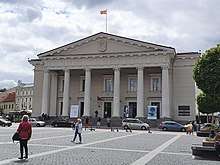
Vilnius Magistrate was responsible for the city economy, was collecting taxes, taking care of the city treasury, was accumulating stocks of grain in order to avoid residents starvation in case of famine or wars. He also acted as a notary in transactions, testaments and as a judge during the city residents conflicts that involved new buildings constructions and reconstructions. His other function was taking care of the city craftsmen. From the beginning, statutes of workshops were approved by the ruler himself. Later, Sigismund II Augustus granted this privilege to the city magistrates in 1552. Since the 1522 privilege by Sigismund I the Old, Vilnius Magistrates had the responsibility to protect the city and its resident's tranquility by having 24 armed guards. During war times, the night watch was performed by three jurisdictions – magistrate, bishop and castle men.[167][169]
Chief City Administrator was vaitas (a Grand Duke of Lithuania vicegerent in the city).[170] Most of them were beginning their careers in the magistracy before obtaining such a position. All vaitai were Catholics. Vaitas was chairing during the City Council meetings. His competence also included criminal cases and he had the right to impose a death penalty. At first, he examined the cases alone, however since the 16th century two suolininkai also examined important cases (if the lawsuit was over 10 groschen) together with the vaitas. In the 16th century, Vilnius City Council consisted of 12 burgomasters and 24 councilors (half of them were Catholics, the other half were orthodoxes). There were no direct elections to the City Council and members to the council were chosen by the wealthy townspeople, merchants, workshops seniors. Burgomasters were being chosen until their deaths. In case of death, another member of the council was being chosen of the same religion. In 1536, Sigismund I the Old signed a privilege which regulated the magistracy formation principles that prohibited to choose close relatives to the council and all the new taxes, obligations and regulations required the prior agreement of the townspeople.[167]
Under the Russian Empire control, the City Council was replaced with City Duma. After the Soviet occupation of Lithuania, Vilnius became a republican subordinate city. The current Vilnius City Municipal Council was established in 1990.[171]
Municipal council of the city
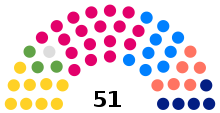
Vilnius City Municipality is one of 60 municipalities of Lithuania and includes the nearby town of Grigiškės, three villages, and some rural areas. The town of Grigiškės was separated from the Trakai District Municipality and attached to the Vilnius City Municipality in 2000.
A 51-member council is elected to four-year terms; the candidates are nominated by registered political parties. As of the 2011 elections, independent candidates also were permitted. The last election was held in March 2019. The results are:
- Public Election Committee "R. Šimašius Team "For Vilnius, which we are proud of" – 17 seats
- A. Zuokas and Vilnius Citizens Coalition "Happy Vilnius" – 10 seats
- Homeland Union – Lithuanian Christian Democrats – 9 seats
- The coalition of the Electoral Action of Poles in Lithuania and Russians Alliance "Christian Families Alliance" – 6 seats
- Labour Party – 5 seats
- Lithuanian Farmers and Greens Union – 3 seats[172]
Mayors

Before 2015, mayors were appointed by the council. Starting with the elections in 2015, the mayors are elected directly by the residents. Remigijus Šimašius became the first directly elected mayor of the city.
- 1990 – Arūnas Grumadas (the president of council)
- 1993 – Valentinas Šapalas (the president of council)
- 1995 – Alis Vidūnas
- 1997 - Algirdas Čiučelis
- 1997 – Rolandas Paksas
- 1999 – Juozas Imbrasas
- 2000 – Rolandas Paksas (second time)
- 2001 – Artūras Zuokas
- 2003 – Gediminas Paviržis
- 2003 – Artūras Zuokas (second time)
- 2007 – Juozas Imbrasas (second time)
- 2009 – Vilius Navickas
- 2010 – Raimundas Alekna
- 2011 – Artūras Zuokas (third time)
- 2015 – Remigijus Šimašius
- 2019 – Remigijus Šimašius (second time)[173]
Subdivisions
Elderships, a statewide administrative division, function as municipal districts. The 21 elderships are based on neighbourhoods:
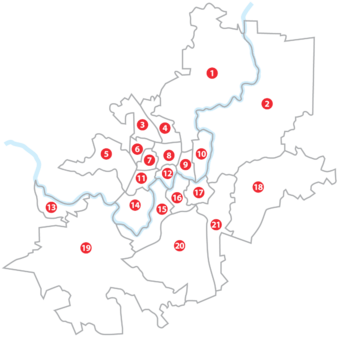
- Verkiai – includes Baltupiai, Jeruzalė, Santariškės, Balsiai, Visoriai
- Antakalnis – includes Valakampiai, Turniškės, Dvarčionys
- Pašilaičiai – includes Tarandė
- Fabijoniškės – includes Bajorai
- Pilaitė
- Justiniškės
- Viršuliškės
- Šeškinė
- Šnipiškės
- Žirmūnai – includes Šiaurės miestelis
- Karoliniškės
- Žvėrynas
- Grigiškės – a separate town
- Lazdynai
- Vilkpėdė – includes Vingis Park
- Naujamiestis – includes bus and train stations
- Senamiestis (Old Town) – includes Užupis
- Naujoji Vilnia – includes Pavilnys, Pūčkoriai
- Paneriai – includes Trakų Vokė, Gariūnai
- Naujininkai – includes Kirtimai, Salininkai, Vilnius International Airport
- Rasos – includes Belmontas, Markučiai[174]
District municipality

Vilnius District Municipality (Lithuanian: Vilniaus rajono savivaldybė) is one of the largest municipalities in Lithuania. It occupies 2129 square kilometres and has 23 civil parishes. There are 1163 villages and 5 towns (Nemenčinė, Bezdonys, Maišiagala, Mickūnai and Šumskas) in the district. Vilnius district surrounds the Lithuania's capital and has developed public, business rural infrastructure and offers high standard of living with clean environment. Vilnius district borders with the Republic of Belarus and neighbours with Švenčionys, Moletai, Širvintos, Elektrėnai, Trakai and Šalčininkai districts.[176]
Vilnius district has a multinational population, of which 52% are Poles, 33% are Lithuanians and the rest of 16% are Russians, Belarusians and other nationalities residents (e.g. Ukrainians, Tatars, Jews). Vilnius district has over 100,000 residents. Most of the population (95%) live in villages and 5% live in towns.[176]
Vilnius district has the highest terrains of Lithuania – Aukštojas, Juozapinė and Kruopinė Hills, which are raised over 290 metres above sea level and are considered very high in the country's flatlands.[176]
Palm Sunday is widely celebrated in the district and the unique and colorful Vilnius Easter palms (verbos) are made there from dried flowers and herbs.[177] The tradition of making Vilnius palms is dated to the times of St. Casimir, who is a patron saint of Lithuania and Lithuanian youth.[176]
Medininkai Castle, Liubavas Manor mill and Bareikiškės Manor are the most famous historical landmarks of the district.[176]
Vilnius Voivodeship from 1769 surrounded a completely independent microstate Republic of Paulava, known for its Age of Enlightenment values, with its own president, peasants parliament, army and laws.[178]
As a result of its large Polish population, Vilnius District Municipality Council mostly consists from members of the Electoral Action of Poles in Lithuania.[179] Lithuanian Pole Marija Rekst is a long-term mayor of the district.[180]
National government
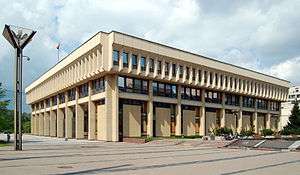
As the capital of Lithuania, Vilnius is the seat of Lithuania's national government. For the executive, the two chief officers of Lithuania have their offices in Vilnius. The President of the Republic of Lithuania resides at the Presidential Palace in Daukanto Square,[181] while the Prime Minister's seat is at the Government of Lithuania office in the Gediminas Avenue.[182] According to the Law of the President of the Republic of Lithuania, the President of the Republic has a residence in Vilnius that is located in Turniškės district near Neris river.[183][184] Prime Minister also has a right to a residence in Turniškės district during term in office.[185] Government ministries are located in various parts of the city; many are located in the Vilnius Old Town.[186]
Historically, the Seimas of the Grand Duchy of Lithuania mostly gathered in Vilnius.[187] The present-day Seimas of the Republic of Lithuania is also located in Vilnius and meets at the Seimas Palace in Gediminas Avenue.[188]
Lithuania's highest courts are located in Vilnius. The Supreme Court of Lithuania (Lithuanian: Lietuvos Aukščiausiasis Teismas), the highest court in the judicial order, which reviews criminal and civil cases, is located in the Gynėjų Street,[189] while the Supreme Administrative Court of Lithuania (Lithuanian: Lietuvos vyriausiasis administracinis teismas), which acts as the highest court in the administrative order, judging litigation against public bodies, is located in the Žygimantų Street.[190] The Constitutional Court of Lithuania (Lithuanian: Lietuvos Respublikos Konstitucinis Teismas), an advisory body with ultimate authority on the constitutionality of laws meets in the Constitutional Court's Palace in Gediminas Avenue.[191]
The Lithuanian Tribunal, the highest appeal court for the nobility of the Grand Duchy of Lithuania, was established by Stephen Báthory, Grand Duke of Lithuania and King of Poland, in 1581. It was located in Vilnius till 1795.[192]
Special services
The security of Vilnius is mainly the responsibility of the Vilniaus apskrities vyriausiasis policijos komisariatas, the highest police office in the city, and local police offices. Its main responsibilities are ensuring public order and public safety, disclosure and investigation of criminal offenses and traffic safety supervision.[193] In 2016, there were 1500 police officers in Vilnius.[194] Viešojo saugumo tarnyba prie Vidaus reikalų ministerijos is responsible for the prompt restoration of public order in extreme and special situations and ensure proper protection of important state objects and escorted subjects.[195]
Vilniaus apskrities priešgaisrinė gelbėjimo valdyba is the primary governing body of the Vilnius's firefighters forces.[196] In the first 9 months of 2018, there were 1287 fire incidents in the city of Vilnius, during which 6 people died and 16 were traumatized.[197]
Vilniaus greitosios medicinos pagalbos stotis is responsible for emergency medical services in the city and can be contacted directly by calling a short number 033.[198] It is one of the oldest emergency medical services institution in Eastern Europe and was established already in 1902.[199] Large part of this institution doctors and other personnel were awarded with medals for their assistance to victims during the January Events in 1991.[199]
Major number for contacting all the special services in Vilnius (and other regions of Lithuania) is 112.[200]
Cityscape
Urbanism and architecture
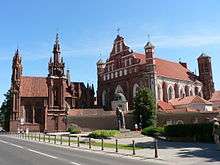

The Old Town of Vilnius is the historical centre of Vilnius, about 3.6 km2 (1.4 sq mi) in size. Its history begins from the Neolithic period. During it, the glacial hills were intermittently occupied and a wooden castle, at the confluence of the Neris and Vilnia rivers, was built around 1000 AD to fortify Gedimino Hill. The settlement developed into a town in the 13th century, when the pagan Baltic people were invaded by the Westerners during the Lithuanian Crusade. Around 1323, when the first written sources about Vilnia occurred, it was the capital of the Grand Duchy of Lithuania, which was formed from various cultures and nationalities residents. At this time, it only had some brick structures. By the 15th century, the Grand Duchy of Lithuania had become one of the most powerful and the largest country in Europe with its territory stretching from the Baltic Sea to the Black Sea (mostly, present-day Belarus, Ukraine and Russia lands). The historic centre consists of three castles territories (Upper, Lower and Curved) and the area that was previously encircled by a Wall of Vilnius. Its plan is mostly circular with its center in the original castle site. The streets pattern is medieval and has small, narrow streets, however large squares were also developed in later periods.[201] Pilies Street, the main artery, links the Palace of the Grand Dukes of Lithuania with Vilnius Town Hall. Other streets meander through the palaces of feudal lords and landlords, churches, shops and craftsmen's workrooms.
The historic buildings are in Gothic (e.g. Church of St. Anne),[204] Renaissance (e.g. Palace of the Grand Dukes of Lithuania),[205] Baroque (e.g. Church of St. Peter and St. Paul with over 2,000 stucco figures interior, Vilnius University's main campus, which features 13 courtyards framed by 15th century buildings and splashed with 300-year-old frescoes, and the Church of St. Johns)[206] and Classical styles (e.g. Vilnius Cathedral, Vilnius Town Hall, Šuazeliai Palace, Verkiai Palace)[207] with splendid exteriors and interiors. The variety of preserved churches and former palaces of the Lithuanian nobility especially constitutes the Vilnius multicultural heritage.[201][208]
As a capital of the massive state, Lithuanians shaped the development of its outstanding capital together with other nations. Vilnius development was influenced by the West and East ideologies. Christianity dominated in Lithuania since the Christianization of Lithuania in 1387, however Orthodoxy of the state's eastern residents and the growing importance of Judaism led to exemplary material manifestations of these religious communities (e.g. Orthodox Cathedral of the Theotokos, Great Synagogue of Vilna).[201]
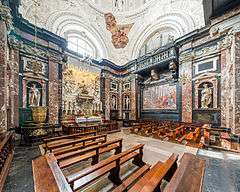
Various disasters resulted in reconstructions of the Vilnius buildings in the School of Vilnius Baroque style, which later left an imprint in the whole Grand Duchy of Lithuania.[201] Talented artists (e.g. Matteo Castelli, Pietro Perti) from the present-day Canton of Ticino were particularly preferred by the Grand Duke of Lithuania and local nobility, and developed many famous objects in the city (e.g. Chapel of Saint Casimir).[209] Lithuanian Laurynas Gucevičius left a huge mark in the Classical style architecture of Vilnius.[210]
During the Soviet occupation decades of Lithuania, microdistricts were built in the elderates of Šeškinė,[211] Žirmūnai,[212] Justiniškės,[213] Fabijoniškės. Most of the buildings from this period had a distinct grey color, straight lines design and poor quality monolith constructions.[214]
Vilnius Old Town was inscribed to the list of the UNESCO World Heritage Sites in 1994. The inscribed property has an extension of 352 ha. Vilnius Historic Centre is particularly noted for maintaining the medieval streets pattern without any significant gaps. However, some places were damaged during Lithuania's occupations and wars, including the Cathedral Square that covers the foundations of the Royal Palace – demolished after the 3rd partition of the Polish–Lithuanian Commonwealth in 1795, a square in the east from the Church of All Saints where the Convent of the Barefoot Carmelites previously stood alongside a Vice-Chancellor Stefan Pac's established Baroque Church of St. Joseph the Betrothed, both demolished by the tsar's order. Great Synagogue and part of the buildings in the Vokiečių Street (German: Deutsche Gasse) were demolished after the World War II.[201]
Vilnius occupies an area of 397 square kilometers, of which only one fifth is developed and the remainder is green belt and water. For this reason, Vilnius is often referred to as one of the 'greenest' capital cities in Europe.[215]
Crypts
The crypts of Vilnius Cathedral are a place where prominent figures of Lithuania and the Church are buried. At the Royal Mausoleum Grand Duke Alexander Jagiellon, Queen Elizabeth of Austria, Barbara Radziwiłł, heart of the Grand Duke Władysław IV Vasa are buried. These crypts also have one of the oldest frescos in Lithuania, painted in the late 14th or early 15th century, and dating to the times of the Christianization of Lithuania.[216]
Housing

Vilnius Old Town (Lithuanian: Vilniaus senamiestis) with idyllic medieval stone paved streets and Užupis offers one of the most prestigious housing in Vilnius. Many old town apartment buildings there offers direct views to the iconic churches or the biggest landmarks of the city (e.g. especially desired Gediminas Tower), enclosed inner courtyards, high ceilings, attics, non-standard layouts and luxurious historic interiors.[217] Most expensive flats in these neighbourhoods may cost millions of euros and are accessible only to the wealthiest residents of the city.[218] However, such problems as traffic jams, expensive car parking spaces, air pollution, high costs of maintenance, limitations for reconstructions repels rich Vilnians from living in these neighbourhoods, who often buy or build private houses in more distant parts of Vilnius (Balsiai, Bajorai, Pavilnys, Kalnėnai, Pilaitė and others) or nearby areas of the Vilnius District Municipality.[217] About 21,000 residents live in the old town and 7,000 in Užupis.[219]
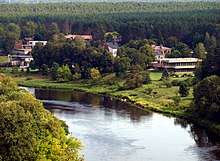
Valakampiai and Turniškės are the city's most prestigious places with private houses quarters as plots there are sufficiently large, surrounded with the greenery, pines forests and are easily accessible from the city centre. Generally, exceptionally wealthy residents and heads of the state (e.g. presidents) live there and most of the larger private houses costs millions of euros.[217][220] Part of the Žvėrynas neighbourhood also offers luxurious private houses with plots close to the Vingis Park, but it also has the Soviet-era apartment buildings, poor condition wooden houses, higher number of residents (~12,200[219]).[217]
Neighbourhoods around the old town (Antakalnis, Žirmūnai, Naujamiestis, Žvėrynas) offer a wide variety prices flats, decent amount of greenery suitable for walks, bicycle roads and therefore are the most popular among the middle class residents. Wealthier communities are living in a new construction apartments or renovated Soviet-era apartments.[217] Government of Lithuania strongly supports the renovation process and compensates 30% or more of the cost.[221] However, poorer inhabitants and low income pensioners are often stopping the process adding to overall regionalistic policies of the politicians.[222][223]
More distant neighbourhoods (e.g. Lazdynai, Karoliniškės, Viršuliškės, Šeškinė, Justiniškės, Pašilaičiai, Fabijoniškės, Naujininkai) are offering significantly cheaper flats. Their biggest disadvantages together with a more difficult communication with the city centre are mostly not renovated Soviet-era high-rise buildings, worn out surroundings, large traffic jams on the streets connecting with the city centre during the rush hours and a constant lack of car parking spaces near older apartments.[217][224]
Šnipiškės eldership has received a significant amount of investment during the 2010s. The area was first mentioned in the Vilnius's historical documents in 1536 when the Grand Duke Sigismund I the Old ordered Ulrich Hosius to build a wooden bridge over the Neris river. Soon around the bridge, a suburb began to develop. In the 16th a palace dedicated to the Muscovites and Tatars messengers built by the magistrate of Vilnius to the north of Šnipiškės, as during their visits, they acted noisily and the townspeople did not want them around.[225] In the 18th century, a Jesuit's Church of St. Raphael the Archangel and monastery as well as solid palaces of the rich and multi-story brick houses of ordinary townspeople were built in Šnipiškės. On the other hand, the outskirts of this suburb were inhabited by the craftsmen: the glass-makers, brick-makers, pottery-makers. Smoking pipe factory, sawmills and even a tiny candy factory emerged. A small part of the territory (8 ha) of Šnipiškės west of the Kalvarijų market, called Skansenas,[226] occupied mostly by poor condition wooden houses, emerged in the late 19th century. Surprisingly, it survived to this day and is now still underdeveloped territory, protected by the state. Next to it, then-luxurious quarter of bankers – Piromontas[227] was built in the 1890s, is architectural heritage too.
.jpg)
During the 1960s, the Šnipiškės area was named the new city center: the first city pedestrian zone organized and before the 1990 a number of buildings, including the largest shopping center in what was then Lithuanian SSR, the highest and the largest hotel, planetarium, museum of Revolution, Pioneer's Palace as well as number of ministries of the Lithuanian SSR were built.[228][229][230][231][232] However, the broader territory of Šnipiškės, stretching to the north of what is now Konstitucijos Avenue, remained mainly underdeveloped until the early 2000s when the new Vilnius city municipality building was built in the area, that inspired transformation of the surroundings: the new Europa square formed with a new shopping center "Europa", 33-story "Europa" business tower and 27-story "Europa" apartment building. Former Museum of Revolution was reconstructed to the National Art Gallery in the late 2000s. Since then skyscrapers and expensive commercial offices are being built constantly in the area. It already has almost 0.5 million square meters of real estate.[233] A Japanese garden will be completed in the area till 2020.[234]
In 2019, average price for 1 m2 of flat was around 2,000 euros and around 1,200 euros for 1 m2 of a private house in Vilnius, while the rent prices were ~10 €/m2 (for flats) and ~8 €/m2 (for private houses) respectively.[235] According to the economists, number of transactions and housing affordability index has reached record highs in 2019 because of the significant rise in Vilnius residents incomes and slowing of the flats prices rising.[236] Despite that, according to a research one fourth of the 26–35 years old inhabitants are still living in their parents or relatives owned homes, which is the highest number in the Baltic states, however it is likely that large part of these young people are simply saving for their own homes or the initial contribution because statistics traditionally shows that Lithuanians purchases their homes with less borrowed funds than Latvians or Estonians.[237]
Demographics
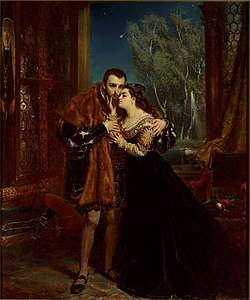
Vilnius has thousands of years of demographics history as in the eldership of Vilkpėdė the remains of the Magdalenian culture settlement were found, which are dated to around 10,000 years BC. In the first 1,000 years AD there were large settlements in Kairėnai, Pūčkoriai and Naujoji Vilnia.[21] The most densely populated area was the confluence of the Neris and Vilnia Rivers, which also had fortified homesteads.[21] Later Vilnius was part of the Kingdom of Lithuania territory, however King Mindaugas did not constantly inhabited in it, despite building the first Catholic Church in Lithuania there on the occasion of his coronation.[239][21] The city began to develop in the late 13th century, during the reign of Grand Dukes Butvydas and Vytenis.[20]
Major growth of Vilnius as the centre and capital of the medieval state is attributed to the 14th century reign of Grand Duke Gediminas whose sent letters to the Western Europe invited knights, merchants, doctors, craftspeople and others to come to the Grand Duchy to practice their trades and faith without restriction.[21] Although, the growth of Vilnius was limited at the time due to the brutal Teutonic Order attacks (e.g. during their assault in 1390 around 14,000 Vilnians were killed) and the Lithuanian Civil War (1389–1392).[21]
Vilnius developed as a multicultural city. In the 14th century sources it is mentioned that Vilnius consists of the Great (Lithuanian) city and Ruthenians city. Until the 16th century the city was mostly inhabited by Lithuanians and Ruthenians, however the German merchants, artisans, Jews (since the 14th century; later had their qahal till 1845) and the Tartars (since 1397) also settled down in Vilnius. In the 16th–17th centuries, during Reformation and Counter-Reformation, the Polonophone population began to grow – by the middle of the 17th century most writings were in Polish due to the Polonisation (before the 16th century the number was only around 5%).[21]
The city prospered during the Golden Age by being one of the main cities of the Polish–Lithuanian Commonwealth and residence of the Lithuanian nobility.[240][241] However, the city was severely devastated by fire in 1610. After the Battle of Vilnius in 1655 the city came under Russian control (1655–1661). Next, after the Great Northern War, the Swedish Empire controlled the city from 1702–1709. This occupation ended during the Great Northern War plague outbreak in 1709. It took the city more than 50 years to recover.[21]

According to the first population census of the Commonwealth in 1790, the Vilnius Voivodeship (without the Grodno County) had a population of 718,571 residents, while the Vilnius County had 105,896 residents (the whole Grand Duchy after the Second Partition had a population of 1,333,493 then).[242] Shortly after, the city population decreased to just 17,500 residents in 1796 due to the fierce battles of the Vilnius uprising in 1794, which was the last attempt to save the Grand Duchy's capital from falling under the complete Russian control.[21][28] Though, after the rebels defeat, Vilnius was incorporated into the Russian Empire and was its third largest city in the beginning of the 19th century.[21] After a few decades of the Russian despotism, Vilnius demographics were once again affected by the November Uprising in 1830 and the January Uprising in 1863, during which rebels attempts were made to restore the statehood.[21] According to the Russian Empire Census of 1897, Vilnius had 154,532 residents and later grown to 205,300 residents in 1909, while the Vilna Governorate had 1,561,713 residents in 1897.[243][244]
During World War I thousands of Vilnians were forced to flee, were killed or were taken to the forced labor camps; consequently the city had only 128,500 residents in 1919 (totally, present-day Lithuania territory lost around 1 million residents).[21][245] Vilnius recovered during the interwar period and had 209,442 residents in 1939,[246] but due to the World War II the number fell to 110,000 in 1944.[21]
Vilnius again grew in population by being capital of the Lithuanian Soviet Socialist Republic (according to the 1989 census, it had 576,747 residents).[21] Despite the fact that almost whole Lithuania suffered from a large emigration after the restoration of independence in 1990, the number of residents in Vilnius remained almost unchanged (542,287 in 2001) and began to steadily grow every year since 2006 to 580,020 residents (as of 1 January 2020).[21][247]
Historic ethnic makeup
| Year | Lithuanians | Poles | Russians | Jews | Others | Total | |||||
|---|---|---|---|---|---|---|---|---|---|---|---|
| 1897[248] | 3,131 | 2% | 47,795 | 30% | 30,967 | 20% | 61,847 | 40% | 10,792 | 7% | 154,532 |
| 1931[249] | 1,579 | 0.8% | 128,600 | 65.5% | 7,400 | 3.8% | 54,600 | 27.8% | 4,166 | 2.1% | 196,345 |
| 1959[250] | 79,400 | 34% | 47,200 | 20% | 69,400 | 29% | 16,400 | 7% | 23,700 | 10% | 236,100 |
| 2001[251] | 318,510 | 57.5% | 104,446 | 18.9% | 77,698 | 14.1% | 2,770 | 0.5% | 50,480 | 9.1% | 553,904 |
| 2011[252] | 337,000 | 63.2% | 88,380 | 16.5% | 64,275 | 12% | N/A | 45,976 | 8.6% | 535,631 | |
.jpg)
Around 1000 years AD, the confluence of the Neris and Vilnia Rivers was densely populated by the Striped Ceramics culture, which had a half a hectare fortified settlement on the Gediminas' Hill.[253] This culture tribes were common throughout present-day Lithuania, east of the Šventoji River and in the western part of Belarus. The direct descendants of this culture are believed to be a Baltic tribe – the Aukštaitians (English: Highlanders).[253] According to a prominent researcher of Vilnius history Antanas Čaplinskas, who researched the surnames of Vilnius residents in the archive documents of the city, the oldest surviving surnames of Vilnius residents are undoubtedly Lithuanian.[253]
Later, following the invitation of Grand Duke Gediminas, merchants and craftsmen began to move to Vilnius from the cities of the German Hanseatic League, France, Italy and Spain, and replaced the Lithuanian surnames with the German, Polish, and Russian surnames.[253] In the late 14th century, during the reign of Grand Duke Algirdas, Vilnius already had a Ruthenian quarter (Latin: Civitas Ruthenica) in the present-day Latako and Rusų Streets, as the trade relations between the Grand Duchy of Lithuania and the Ruthenian principalities were quite well developed, therefore quite a few Ruthenian merchants lived there and the Ruthenian nobles had their residences in the quarter.[253][254] The variety of nations in Vilnius was further increased by Grand Duke Vytautas the Great, who introduced Jews, Tatars, Crimean Karaites.[255] After a few hundred years, the number of locals in Vilnius was smaller than the number of newcomers.[253] Though, according to the analysis of the tax registers of 1572, Lithuania proper had 850,000 residents, of which 680,000 (80%) were Lithuanians.[242] The word about the Lithuanian language spread wide as even the Byzantine Greek historian Laonikos Chalkokondyles knew that the Lithuanians have their own distinct language.[256]
Since the Polish–Lithuanian Commonwealth times, the Polish culture began to penetrate the city rapidly and soon the Polish language prevailed in the city, even the Magistrate documents were written in Polish until the November Uprising in 1831.[253] After living for a while in Vilnius, foreign merchants and artisans quickly assimilated and were Polonized.[253] Majority of the Lithuanian nobles were also Polonized and spoke the Polish language, however they never considered themselves Poles and the Union of Lublin was only signed during the second attempt in 1569, with the agreement that both states will be sovereign entities within the Commonwealth and the forbidment for the Poles from the Crown of the Kingdom of Poland to buy land in the Grand Duchy of Lithuania.[257] Their opinion did not changed within the union and was confirmed again in the Reciprocal Guarantee of Two Nations in 1791.[258]
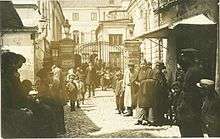
Over the centuries, the composition of the population of Vilnius even more changed for the benefit of non-Lithuanians.[253] According to historian Vytautas Merkys, the city lost a great deal of its old population during the brutal rampages of the Swedish and Russian armies in the 17th and 18th centuries, and they were replaced by the newcomers, however the Lithuanians also constantly inhabited in Vilnius.[253] According to the Russian Empire Census of 1897, only 2.1% (3200 residents) identified themselves as Lithuanian-speakers, while the Poles (30.8%; 47,600 residents) and the Jews (40.0%; 61,800 residents) were the largest ethnic groups of the city.[259] Though, according to the Parish censuses of 1857–1858, the Lithuanians population remained significant in the Vilna Governorate and, according to different authors, was between 23.6% and 50.0% (210,273–418,880 residents).[243] Among the nobility class in Vilnius during the census of 1897, there were 5,301 (46.3%) local nobles and 6,403 (54.7%) newcomers, of these 24.1% noble newcomers came from Vilna Governorate territories, while the rest newcomers nobles came to Vilnius from Grodno Governorate, Minsk Governorate, Vitebsk Governorate, Kovno Governorate, Vistula Land and other regions.[260]
Ethnic Lithuanians numbers in the city of Vilnius reached record lows in 1931 (1600 residents – 0.8%, while the Poles accounted for 65.9% – 128,600 residents) following the 1922 annexation of Vilnius Region by Poland and the Lithuanians retreat from the region to the temporary capital Kaunas.[261] Though, following the Soviet–Lithuanian Mutual Assistance Treaty in 1939, Lithuania recovered the Vilnius Region and made efforts to Lithuanize Vilnius by the introduction of Lithuanian laws.[262] Prime Minister Antanas Merkys once said that it was intended "to make everybody think like Lithuanians. First of all, it was and still is necessary to comb out the foreign element from the Vilnius Region".[262] The Lithuanian Government put into force a law according to which "who on July 12, 1920 (...) were regarded as Lithuanian nationals, and on October 27, 1939 were resident in the territory became Lithuanian nationals" (this definition of citizenship was used to dismiss a large number of Polish civil servants and ~150,000 Poles were later repatriated from the Lithuanian SSR).[262] Almost the whole Lithuanian Jews population was exterminated during the Nazis organized Holocaust in 1941.[261] After the World War II, the Lithuanians numbers in the city started recovering (e.g. there already were 79,363 Lithuanians in 1959, who accounted for 33.6% of all residents in the city), however the Lithuanization ideas were mostly replaced with the Sovietization of the population after the rigged election to the People's Seimas in 1940.[261][250] Following the restoration of independence in 1990, the Lithuanians population in the city continued to grow and according to the 2011 Lithuanian census already reached 63.2% (337,000 residents).[252]
Economy
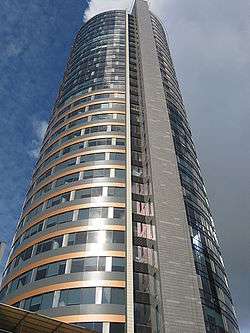
Vilnius is the major economic centre of Lithuania. GDP per capita (nominal) in Vilnius county was €23,400 ($47,969, in Purchasing power parity, 2015 constant USD)[263][264] in 2018, making it the wealthiest region in Lithuania and second wealthiest region in Baltic states.
The budget of Vilnius reached €759 million in 2020[265]. The average monthly net salary in Vilnius city municipality reached €1,000 (as of 2020)[266].
Since 2010, employment and unemployment indicators have continuously been improving in Lithuania. Employment reached a record high of 77.5% in the third quarter of 2018 while unemployment was 6.3% in the fourth quarter, a rate last observed in 2008. Nevertheless, this has to be seen in the context of a shrinking working age population. The activity rate reached 82% in 2017. Vilnius and Kaunas counties offer better labour market opportunities than other counties, and this drives the internal interregional migration. However, in other regions employment opportunities remain scarce. Unemployment rates remained persistently high in the least developed regions (14.9% in Utena County as compared to 4.8% in Vilnius County). Other key labour market indicators have improved, returning to pre-crisis levels. Long-term unemployment fell to 2.1% in the third quarter of 2018 (EU average: 2.9%). Youth unemployment (13.3%) and the rate of young people not in employment, education or training (NEET, at 9.1%) were below the EU average in 2017.[267]

Overall, the share of the population at risk of poverty or social exclusion (AROPE) has decreased since Lithuania joined the EU in 2004. However, it remains among the highest in the EU (29.6% in 2017, compared to 22.4% in the EU). The risk of poverty or social exclusion in rural areas is nearly double that of urban areas, which corresponds to the gap in the unemployment rate between cities and rural areas (4.5% versus 11% in 2017). In particular the metropolitan areas of Vilnius and Kaunas, where significant economic activity is centred, drive a significant gap between AROPE rates in urban and rural areas. In 2017, the AROPE rate in rural areas was 37.2%, compared to 19.9% in cities.[269]
Over the past 15 years, Lithuania has experienced the fastest convergence in the EU, but the benefits of economic growth are uneven across regions. Disparities among Lithuania's regions have steadily grown in this period. While GDP per capita reached nearly 110% of the EU average in the capital region of Vilnius, it is only between 42% and 77% in other regions. The country's rapid convergence is mainly fuelled by two regions – the capital region of Vilnius and Kaunas County – producing 42% and 20% of the national GDP, respectively. In 2014–2016 these regions grew on average by 4.6% (Vilnius) and 3.3% (Kaunas), while the other regions, which have a higher share of rural areas, stagnated or were in recession.[270]
The supply of new housing in Vilnius and its suburbs, the country's biggest real estate market, has reached post-crisis highs and the stock of unsold apartments in the three largest cities has started to increase since the beginning of 2017. The demand for housing is still strong, fuelled by rapidly rising wages, benign financial conditions and positive expectations. In the first half of 2018, the number of monthly transactions was the highest since the 2007–2008 peak.[271] Most foreign direct investment and productive public investment in Lithuania is concentrated around the two main economic development poles of Vilnius and Kaunas.[272]
Vilnius Industrial Park is located 18.5 kilometres from the city and its land is intended for commercial, industrial use.[273]
Science and research
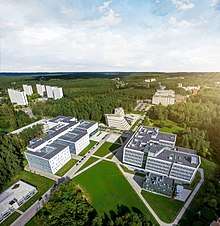
Sunrise Valley Science and Technology Park (Lithuanian: Saulėtekio slėnio mokslo ir technologijų parkas) is a non-profit organization, founded in 2003. The park is the centre of entrepreneurship, promotion of business and science collaboration, provision of infrastructure and other innovation support. Over 20,000 students study in the Vilnius University and Vilnius Gediminas Technical University facilities in the Sunrise Valley and 5,000 scientists performs their research in the corresponding science centres there.[274]
Centre for Physical Sciences and Technology (Lithuanian: Fizinių ir technologijos mokslų centras) or FTMC is the largest scientific research institution in Lithuania, which specialises in laser technologies, optoelectronics, nuclear physics, organic chemistry, bio and nano technologies, electrochemical material science, electronics, and other scientific fields. The centre was created in 2010 by merging institutes of Chemistry, Physics, Semiconductor Physics in Vilnius and Textile institute in Kaunas.[275] The centre features 250 laboratories (24 open to the public) and can accommodate more than 700 researchers and students.[276] Furthermore, the centre also offers PhD Studies and annually helds FizTech conferences of PhD students and young researchers.[277] FTMC is the founder and sole shareholder of the Science and Technology Park of Institute of Physics in Savanorių Avenue, which provides assistance to companies operating in research and development field.[278]
Laser Research Centre of Vilnius University (Lithuanian: Vilniaus universiteto Lazerinių tyrimų centras) is an open access centre, mostly used by the Department of Quantum Electronics, which prepares highly qualified physicists, laser physicists and laser technology specialists. The department carries out world-class research in laser physics, nonlinear optics, optical component characterization, biophotonics and laser microtechnology.[279] Lithuania is one of the world's leaders in producing laser technologies and has over 50% of the world's market share in ultrashort pulses lasers, which are produced by the Vilnius-based companies.[280] In 2019, they developed one of the world's most powerful laser system in the world SYLOS for the Extreme Light Infrastructure laboratory in Szeged, which produces high-intensity ultra-short pulses with a peak power of up to a thousand times that of the most powerful nuclear power plant in the United States.[280] Also, Corning Inc. has bought the licence for the state-of-the-art glass cutting solutions from the Vilnius-based laser company Altechna and uses it for manufacturing billions of Gorilla Glasses.[281]
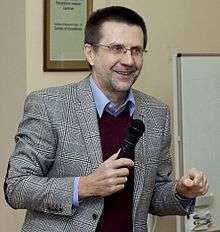
Vilnius University Life Sciences Centre (Lithuanian: Vilniaus universiteto Gyvybės mokslų centras) is a scientific research centre, which consists of three institutes: Institute of Biochemistry, Institute of Biosciences and Institute of Biotechnology. The centre was opened in 2016 and has 900 students, ~120 PhD students and 250 scientific-pedagogical staff that are able to use open access scientific laboratories equipped with the most advanced equipment there.[282] Next to the main building there is a Technology Business Incubator for small and medium businesses in life sciences or related fields.[283]
Vilnius Gediminas Technical University has three research centres in the Sunrise Valley: Civil Engineering Research Centre, Technology Centre for Building Information and Digital Modelling, Competence Centre of Intermodal Transport and Logistics.[284]
Lithuanian Social Research Centre (Lithuanian: Lietuvos socialinių tyrimų centras) in A. Goštauto St. 9 analyzes the socio-economic, political and demographic processes and helps clients in public and private sectors. The centre closely cooperates with the Government of Lithuania.[285]
Santara Valley (Lithuanian: Santaros slėnis) is a second science and research valley in Vilnius, which focuses on the medicine, biopharmaceutical and bioinformatics areas.[286] Vilnius University Faculty of Medicine Science Centre, costing €37.1 million, will be completed in the valley in 2021.[287]
Jonas Kubilius, long-term rector of the Vilnius University is known for works in Probabilistic number theory, Kubilius model, Theorem of Kubilius and Turán–Kubilius inequality bear his name. Jonas Kubilius successfully resisted attempts to Russify the Vilnius University.[288] Vilnian Marija Gimbutas was the first to formulate the Kurgan hypothesis. In 1963, Vytautas Straižys and his coworkers created Vilnius photometric system that is used in astronomy.[289] Kavli Prize laureate Virginijus Šikšnys is known for his discoveries in CRISPR field – invention of CRISPR-Cas9 gene editing.[290]
Information technology
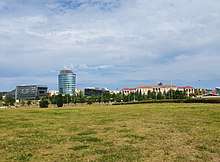
Lithuania and its capital Vilnius is an attractive place for foreign companies to open their offices. This is due to several main reasons – highly qualified employees and good infrastructure.[291] Several high schools are preparing skilled specialists in Vilnius, most notably the Vilnius University Faculty of Mathematics and Informatics and Vilnius Gediminas Technical University Faculty of Fundamental Sciences.[292][293] Sphere of the information technology is an attractive profession among the qualified professionals due to the high salaries in Vilnius (e.g. Lithuanian branch of Google, established in Vilnius, offers ~€17,800 monthly salary, which is one of the highest in Lithuania).[294] In 2018, the annual output of the information technology sector in Lithuania was €2.296 billion, of which large amount was created in Vilnius.[295]
Vilnius Tech Park in Sapieha Park is the biggest information technology startup hub in the Baltic and Nordic countries and unites international startups, technology companies, accelerators, incubators.[296] In 2019, the fDi Intelligence (an investment experts subdivision of the Financial Times) ranked Vilnius as number one city in the Tech Start-up FDI Attraction Index.[297]
In 2011, Vilnius had the fastest internet speed in the world[298] and despite the fall in the rankings in recent years – it still remained as one of the fastest around the globe.[299] Vilnius Airport also has one of the fastest wireless public internet (Wi-Fi) among the European airports.[300]
National Cyber Security Centre of Lithuania was established in Vilnius due increasing internet attacks against the Lithuanian Government organizations.[301]
Bebras is an international informatics and information technology contest, which is held annually for pupils of 3–12 grades since 2004.[302] Since 2017, computer programming is taught in the primary schools.[303]
Lithuania and especially its capital Vilnius is a popular fintech companies hub due to the state's flexible regulations in the e-money licences field.[304] In 2018, Bank of Lithuania granted an electronic money licence to the Google Payment Lithuania company, based in Vilnius.[305] Since 2018, prominent e-money startup Revolut also has an e-money licence and headquarters in Vilnius, furthermore in 2019 it began to move its clients to the Lithuanian company Revolut Payments.[306] On 23 January 2019, the Europe's first international Blockchain Centre was opened in Vilnius.[307]
Finance and banking
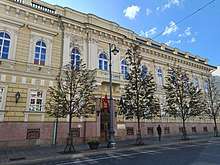
Being capital of Lithuania, Vilnius is the centre of country's finances. The Ministry of Finance is located in Vilnius and is responsible for the development and enforcement of an efficient public financial policy with a view to ensuring the macroeconomic stability of the state and its economic growth.[308] The Bank of Lithuania is also headquartered in Vilnius and fosters a reliable financial system and ensures sustainable economic growth.[309] Nasdaq Vilnius Stock Exchange, a leading stock exchange in Lithuania, is located in K29 business centre in Konstitucijos Avenue.[310]
The National Audit Office of Lithuania (Lithuanian: Lietuvos Respublikos valstybės kontrolė) is located in V. Kudirka Street and helps the state to manage public funds and property wisely.[311] While the State Tax Inspectorate (Lithuanian: Valstybinė mokesčių inspekcija) is headquartered in Vasario 16-osios Street and is responsible for collecting or refunding taxes in the country.[312]
At the time, 7 banks in Lithuania are holding a bank or a specialised bank licence, while 9 banks are carrying out their activities as foreign bank branches. The two largest banks registered in Lithuania (AB SEB bankas, Swedbank, AB,) are supervised directly by the European Central Bank jointly with Bank of Lithuania experts.[313]
The majority of the Lithuanian financial system consists of Nordic capital banks.[314]
Education

Tertiary education
The city has many universities. The largest and oldest is Vilnius University with 19,768 students.[315] Its main premises are in the Old Town. The university has been ranked among the top 500 universities in the world by QS World University Rankings.[316] The University is participating in projects with UNESCO and NATO, among others. It features Masters programs in English and Russian,[317] as well as programs delivered in cooperation with universities all over Europe. The university is divided into 14 faculties.[315]
Other major universities include Mykolas Romeris University (7,500 students[318]), Vilnius Gediminas Technical University (9,600 students[319]), and Lithuanian University of Educational Sciences (merged into Vytautas Magnus University in 2018).[320] Specialized higher schools with university status include General Jonas Žemaitis Military Academy of Lithuania, Lithuanian Academy of Music and Theatre and Vilnius Academy of Arts. The museum associated with the Vilnius Academy of Arts holds about 12,000 artworks.[321]
There are also a few private universities such as ISM University of Management and Economics, European Humanities University and Kazimieras Simonavičius University.
Several colleges are also in Vilnius including Vilnius College, Vilnius College of Technologies and Design, International School of Law and Business and others.
Primary and secondary education

Primary and lower secondary education is mandatory in Lithuania. Children must start attending pre-primary education since 6 years old and education is compulsory until the age of 16. Primary and secondary education is free at all stages, however there also are private schools with tuition fees in Vilnius. The education system is governed by the Government of Lithuania and the Ministry of Education, Science and Sports of Lithuania which headquarters are in Vilnius.[322]
Cathedral School of Vilnius, first mentioned in 1397, is the earliest known Lithuanian school.[21] Vilnius Vytautas the Great Gymnasium, established in 1915, is the first Lithuanian gymnasium in Eastern Lithuania.[323] In 2018, the city had 120 schools (not including preschools) with 61,123 pupils and 4,955 educators.[324] Four out of five best rated schools in Lithuania are located in Vilnius, while the Vilnius Lyceum is the number one.[325]
Ethnic minorities in Lithuania are allowed to have their own schools. In Vilnius there are 7 elementary schools, 8 primary schools, 2 progymnasiums and 12 gymnasiums dedicated exceptionally for minorities children where lessons are conducted in minorities languages only. In 2017, there were 4,658 Poles and 9,274 Russians who studied in their minorities languages in the city.[326]
Vilnius has 11 vocational schools which provides vocational education.[327]
National M. K. Čiurlionis School of Art is the only art school in Lithuania spanning the entire 12-year learning cycle. Vilnius Justinas Vienožinskis Art School is another prominent art school in Vilnius.
Most of the school graduates in Vilnius later studies in the universities or colleges as Lithuania is one of the world's leading countries in OECD's statistics of population with tertiary education (56% of 25–34 year-olds in 2018).[328]
Libraries
The Central Library of Vilnius City Municipality (Lithuanian: Vilniaus miesto savivaldybės centrinė biblioteka) operates public libraries in Vilnius.[330] It has 17 public libraries, located in different elderships of Vilnius, 2 of them (libraries Saulutė and Papartis) are dedicated to children's literature only.[331] Large part of these libraries organizes computer literacy courses that are free of charge.[332] Usage of public libraries requires a free LIBIS (integrated information system of Lithuanian libraries) card.[333]
Martynas Mažvydas National Library of Lithuania (Lithuanian: Lietuvos nacionalinė Martyno Mažvydo biblioteka), located in Gediminas Avenue and founded in 1919, is a national cultural institution which collects, organizes and preserves Lithuania's written cultural heritage content, develops the collection of Lithuanian and foreign documents relevant to research, educational and cultural needs of Lithuania, and provides library information services to the public.[334] As of 1 July 2019, its electronic catalog has 1,140,708 bibliographic records.[335]
The Wroblewski Library of the Lithuanian Academy of Sciences (Lithuanian: Lietuvos mokslų akademijos Vrublevskių biblioteka) is a scientific library of state significance, a cultural, scientific and educational institution. Its founder is the Lithuanian Academy of Sciences. All citizens of Lithuania and foreign countries are entitled to use the services of the Library.[336] As of 1 January 2015, the stock of the Library counted 3,733,514 volumes. On 1 January 2015, the Wroblewski Library of the Lithuanian Academy of Sciences had 12,274 registered users.[336]
Every Lithuanian university and college has its own library, dedicated to their students, professors and alumni. The most notable modern university library is the National Open Access Scientific Communication and Information Center of Vilnius University (Lithuanian: Vilniaus universiteto bibliotekos Mokslinės komunikacijos ir informacijos centras) in Saulėtekis Valley, which was opened in 2013 and offers over 800 workplaces in total area of 14043,61 m2.[337][338] Central Vilnius University Library,[339] Vilnius Gediminas Technical University Library, Mykolas Romeris University Library, ISM University of Management and Economics Library, European Humanities University Library, Kazimieras Simonavičius University Library are located in these universities complexes in Vilnius.[340]
Religion
| Religion | People | % |
|---|---|---|
| Roman Catholic | 350,797 | 65.5% |
| Eastern Orthodox | 47,827 | 8.9% |
| Old Believers | 5,593 | 1.0% |
| Evangelical Lutheran | 1,594 | 0.3% |
| Evangelical Reformed | 1,186 | 0.2% |
| Sunni Muslim | 798 | 0.2% |
| Jewish | 796 | 0.2% |
| Greek Catholic | 167 | <0.1% |
| Karaites | 139 | <0.1% |
| Other | 5,050 | 0.9% |
| None | 47,655 | 8.9% |
| No response | 74,029 | 13.8% |
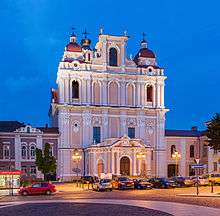
.jpg)
Already in the 17th century Vilnius was known as a city of many religions. In 1600, Samuel Lewkenor's book describing cities with universities was published in London.[342] Lewkenor mentions that citizens of Vilnius included Catholics, Orthodox, followers of John Calvin and Martin Luther, Jews and Tartar Muslims.
Throughout the 17th century Vilnius had a reputation as a city which had no rivals in Europe in the number of churches of different confessions. At the end of the century, this reputation was confirmed by the highly regarded (and several times republished) work by Robert Morden, "Geography Rectified or a Description of the World", which said that no other city in the world could surpass Vilnius in the number of churches and temples of various faiths, except perhaps Amsterdam.[343][344]
Today Vilnius is the seat of the Roman Catholic Archdiocese of Vilnius, with the main church institutions and Archdiocesan Cathedral (Vilnius Cathedral) here. Numerous Christian Beatified persons, martyrs, Servants of God and Saints, are associated with Vilnius. These, among others, include Franciscan martyrs of Vilnius, Orthodox martyrs Anthony, John, and Eustathius, Saint Casimir, Josaphat Kuntsevych, Andrew Bobola, Raphael Kalinowski, Faustina Kowalska, Jurgis Matulaitis-Matulevičius.
There are a number of other active Roman Catholic churches in the city, along with small enclosed monasteries and religion schools. Church architecture includes Gothic, Renaissance, Baroque and Neoclassical styles, with important examples of each found in the Old Town. Additionally, Eastern Rite Catholicism has maintained a presence in Vilnius since the Union of Brest. The Baroque Basilian Gate is part of an Eastern Rite monastery.
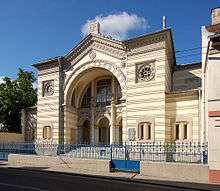
Once widely known as Yerushalayim De Lita (the "Jerusalem of Lithuania"), Vilnius, since the 18th century, was a world centre for the study of the Torah, and had a large Jewish population. A major scholar of Judaism and Kabbalah centred in Vilnius was the famous Rabbi Eliyahu Kremer, also known as the Vilna Gaon. His writings have significant influence among Orthodox Jews to this day. Jewish life in Vilnius was destroyed during the Holocaust; there is a memorial stone dedicated to victims of Nazi genocide in the centre of the former Jewish Ghetto – now Mėsinių Street. The Vilna Gaon Jewish State Museum is dedicated to the history of Lithuanian Jewish life. The site of Vilnius's largest synagogue, built in the early 1630s and wrecked by Nazi Germany during its occupation of Lithuania, was found by ground-penetrating radar in June 2015, with excavations set to begin in 2016.[345][346]
The Karaites are a Jewish sect that migrated to Lithuania from the Crimea. Although their numbers are very small, the Karaites are becoming more prominent since Lithuanian independence, and have restored their kenesas (e.g. Vilnius Kenesa).[347]
Vilnius has been home to an Eastern Orthodox Christian presence since the 13th or even the 12th century. A famous Russian Orthodox Monastery of the Holy Spirit, is near the Gate of Dawn. St. Paraskeva's Orthodox Church in the Old Town is the site of the baptism of Hannibal, the great-grandfather of Pushkin, by Tsar Peter the Great in 1705. Many Old Believers, who split from the Russian Orthodox Church in 1667, settled in Lithuania. The Church of St. Michael and St. Constantine was built in 1913. Today a Supreme Council of the Old Believers is based in Vilnius.
A number of Protestant and other Christian groups[348] are represented in Vilnius, most notably the Lutheran Evangelicals and the Baptists.
The pre-Christian religion of Lithuania, centred on the forces of nature as personified by deities such as Perkūnas (the Thunder God), is experiencing some increased interest. Romuva established a Vilnius branch in 1991.[349]
Pilgrimage
— From the speech of Pope John Paul II at the Dominican Church of the Holy Spirit during his visit to Lithuania in 1993.[350]
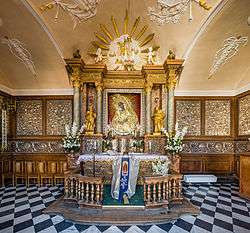
Since the Christianization of Lithuania in 1387, Vilnius had become one of the main centres of Christianity in Lithuania and a Christian pilgrimage site. Vilnius Pilgrimage Centre (Lithuanian: Vilniaus piligrimų centras) coordinates pilgrimages, assists in their proper preparation, and takes care of pilgrimage pastoral care.[351] Many places in Vilnius are associated with divine miracles or marks significant events to the Christians. Chapel of the Gate of Dawn is visited by thousands of Christian pilgrims annually. Initially, the gates were part of the defensive Wall of Vilnius, however in the 16th century they were given to the Carmelites, who installed a chapel in the gates with a prominent 17th century Catholic painting Our Lady of the Gate of Dawn. The painting was later decorated with gold-plated silver embellishments and is surrounded by a legend and divine miracles.[352]

Sanctuary of the Divine Mercy is another important pilgrimage site, which has the Divine Mercy image. Vilnius became the birthplace of the Divine Mercy Devotion when Saint Faustina began her mission under the guidance and discernment of her new spiritual director, blessed Michał Sopoćko. In 1934, the first Divine Mercy image was painted by Eugeniusz Kazimirowski under the supervision of Faustina Kowalska and it presently hangs in the Divine Mercy Sanctuary in Vilnius. A feast of the Adoration of the Blessed Sacrament is held in the shrine 24 hours per day.[352] The House of St. Faustina where she previously lived is located in V. Grybo St. in Antakalnis and is open to the pilgrims everyday.[353]
Church of St. Philip and St. Jacob near the Lukiškės Square has the painting of the Mother of God of Lukiškės, which is glorified by divine miracles.[352] The icon was painted in the 15th – 16th centuries and is one of the oldest monuments of easel painting in Lithuania.[354] It was brought by the Grand Duchy of Lithuania artillery general Motiejus Korvinas Gosievskis from the wars with Muscovites. From 1684 onwards miracles began to be experienced in the Vilnius Dominican Monastery, related to the image of Mother of God of Lukiškės, which in 1737 were published in a miracles book Mystical fountain (Lithuanian: Mistinis fontanas). The icon was restored and returned to the Dominicans in 2012.[355]
Three Crosses is a prominent monument in Vilnius. According to a debated legend of the Franciscan martyrs of Vilnius, presented in the Bychowiec Chronicle, fourteen Franciscan friars were invited to Vilnius from Podolia by Petras Goštautas.[356] The friars publicly preached the gospel and badmouthed Lithuanian gods. Angered city residents burned the monastery and killed all fourteen friars. Seven of them were beheaded on the Bleak Hill; the other seven were crucified and thrown into the Neris or Vilnia River.[356]
Verkiai Calvary (or Vilnius Calvary) is the second oldest calvary in Lithuania after Žemaičių Kalvarija. It is located in Verkiai, a neighborhood of Vilnius. The Calvary was built in 1662–69 as a sign of gratitude for the victory in the Second Northern War (1655–60).[357] The consecration ceremony of the new Stations of the Cross took place at Pentecost on 9 June 1669.[358] The Calvary includes 20 brick chapels, seven wooden and one brick gate, and one bridge with a wooden chapel.[359] The path ends at the Church of the Discovery of the Holy Cross. In 1962 all chapels, except four closest to the church, were destroyed by the Soviet authorities with dynamites over night. The Calvary was reconstructed in 1990–2002 and the chapels were solemnly consecrated at Pentecost in 2002.[360] Pilgrimages in the Calvary are organized regularly with the clergy.[361]
Church Heritage Museum (Lithuanian: Bažnytinio paveldo muziejus) exhibits the oldest and largest of all the churches of the Grand Duchy of Lithuania treasure trove of the Vilnius Cathedral and liturgical artefacts from other churches of the Roman Catholic Archdiocese of Vilnius.[352][362]
Vilnius is the only city in the Baltic states with an Apostolic Nunciature, in which Pope John Paul II and Pope Francis stayed during their visits to Lithuania, Latvia and Estonia.[363]
Parks, squares and cemeteries
Almost half of Vilnius is covered by green areas, such as parks, public gardens, natural reserves. Additionally, Vilnius is host to numerous lakes, where residents and visitors swim and have barbecues in the summer. Thirty lakes and 16 rivers cover 2.1% of Vilnius's area, with some of them having sand beaches.
Vingis Park, the city's largest, hosted several major rallies during Lithuania's drive towards independence in the 1980s. Sections of the annual Vilnius Marathon pass along the public walkways on the banks of the Neris River. The green area next to the White Bridge is another popular area to enjoy good weather, and has become venue for several music and large screen events.
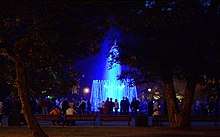
Cathedral Square in Old Town is surrounded by a number of the city's most historically significant sites. Lukiškės Square is the largest, bordered by several governmental buildings: the Lithuanian Ministry of Foreign Affairs, the Ministry of Finance, the Polish Embassy, and the Genocide Victims' Museum, where the KGB tortured and murdered numerous opposers of the communist regime. An oversized statue of Lenin in its centre was removed in 1991. Town Hall Square has long been a centre of trade fairs, celebrations, and events in Vilnius, including the Kaziukas Fair. The city Christmas tree is decorated there. State ceremonies are often held in Daukantas Square, facing the Presidential Palace.
On 20 October 2013, Bernardinai Garden, near Gediminas Tower, previously known as Sereikiškės Park, was opened after reconstruction. The authentic 19th century Vladislovas Štrausas environment was restored.[364] It is a venue for concerts, festivals, and exhibitions.
Rasos Cemetery, consecrated in 1801, is the burial site of Jonas Basanavičius and other signatories of the 1918 Act of Independence, along with the heart of Polish leader Józef Piłsudski. Two of the three Jewish cemeteries in Vilnius were destroyed by communist authorities during the Soviet era; the remains of the Vilna Gaon were moved to the remaining one. A monument was erected at the place where Užupis Old Jewish Cemetery was.[365] About 18,000 burials have been made in the Bernardine Cemetery, established in 1810; it was closed during the 1970s and is now being restored. Antakalnis Cemetery, established in 1809, contains various memorials to Polish, Lithuanian, German and Russian soldiers, along with the graves of those who were killed during the January Events.
Tourism
.jpg)
According to the data collected by the Lithuanian Department of Statistics, a total of 1,200,858 visitors had rented rooms in Vilnius accommodation venues where they spent a total of 2,212,109 nights in 2018. Compared to the 2017 statistics, the number of guests grew by 12% and 11% respectively.[366]

In 2018 81% of all the visitors who stayed in Vilnius were foreigners (970,577), which is 11% more than the previous year. Most foreign visitors came from Belarus (102,915), Germany (101,999), Poland (99,386), Russia (90,388) and Latvia (61,829). Guests from these countries accounted for 47% of all foreign guests, who rented rooms in Vilnius accommodation venues.[366] Entirely, 230,281 Lithuanians (19% of all guests) were in Vilnius accommodation venues during 2018 (which is 18% more than in 2017).[366]
According to a 2018 Vilnius Visitors Survey, 48% of tourists visited Vilnius for the first time, 85% of tourists planned the trip by themselves and 15% travelled with travel agencies.[367] According to the same survey, 40% of tourists specified that they decided to visit Vilnius in order to learn about the history and heritage of the city; however, 23% of tourists also planned trips to other areas of Lithuania (e.g. Trakai, Kaunas, Druskininkai, Šiauliai, etc.).[368] Many Belarusians (~200 000 granted travel visas annually) are arriving for shopping in the city's shopping malls and upon departing submits even half a meter long receipts to the customs.[369]
In 2018 Vilnius Tourist Information Centres were visited by a total of 119,136 visitors (95,932 foreigners and 23,204 Lithuanians), a 5% increase compared with the 2017 statistics. In 2017 the centres were visited by 113,818 visitors (97,072 foreigners and 16,746 Lithuanians).[366]
The best-rated tourists services in Vilnius are restaurants (cafés) services quality, old town attractions, hotels (or other accommodation places) services, trips to Trakai, parks (green zones), connection with the Vilnius Airport, food in hotels, restaurants, cafés.[370]
In the City Costs Barometer 2019, Vilnius was ranked as number one among the European capitals for offering best value to visitors.[371]
The Vilnius Palace of Concerts and Sports is slated in 2022 to be transformed into the leading convention center in the Baltic states. The controversial project has been approved by the Lithuanian Jewish Community.[372]
Hotels
Lithuania is a member of the European Hotelstars Union, which is providing a harmonised hotel classification with common criteria and procedures in the participating countries.[373] Vilnius has six 5 stars hotels, all are located in the Vilnius Old Town.[374] In addition to this, there are twenty-seven 4 stars hotels.[375] Grand Hotel Kempinski Vilnius with direct view to the Cathedral Square is considered as the most luxurious hotel in Vilnius and offers presidential rooms for around 3000 euros per night (more than three times of the average monthly net salary in Vilnius[376]) and is frequently chosen by the heads of state, movie stars, famous musicians and other celebrities during their visits to Lithuania.[377]
In 2019, Vilnius had 82 hotels, 8 motels and 40 other accommodation places with 6,822 rooms and 15,248 beds. The highest hotels rooms’ occupancy was in August and the lowest in February.[366]
According to a 2018 Vilnius Visitors Survey, 44% of Vilnius visitors stayed in the middle class hotels (3–4 stars), 12% stayed in standard or economic class hotels (1–2 stars) and 11% stayed in luxurious 5 star hotels.[378]
Sports

Several teams are based in the city. The largest is the basketball club BC Rytas, which participates in European competitions such as the Euroleague and Eurocup, the domestic Lithuanian Basketball League, winning the ULEB Cup (predecessor to the Eurocup) in 2005 and the Eurocup in 2009. Its home arena is the 2,500-seat Lietuvos Rytas Arena; all European matches and important domestic matches are played in the 11,000-seat Siemens Arena.
Vilnius also has several football teams. FK Žalgiris is the main football team. The club plays at LFF Stadium in Vilnius (capacity 5,067).[379]
Olympic champions in swimming Lina Kačiušytė and Robertas Žulpa are from Vilnius. There are several public swimming pools in Vilnius with Lazdynai Swimming Pool being the only Olympic-size swimming pool of the city.[380]
The city is home to the Lithuanian Bandy Association, Badminton Federation, Canoeing Sports Federation, Baseball Association, Biathlon Federation, Sailors Union, Football Federation, Fencing Federation, Cycling Sports Federation, Archery Federation, Athletics Federation, Ice Hockey Federation, Basketball Federation, Curling Federation, Rowing Federation, Wrestling Federation, Speed Skating Association, Gymnastics Federation, Equestrian Union, Modern Pentathlon Federation, Shooting Union, Triathlon Federation, Volleyball Federation, Tennis Union, Taekwondo Federation, Weightlifting Federation, Table Tennis Association, Skiing Association, Rugby Federation, Swimming Federation.[381]
Vilnius Marathon is an international marathon with thousands of participants every year.
Vilnius is one of the host cities for the 2021 FIFA Futsal World Cup.
Transport

Navigability of the river Neris is very limited and no regular water routes exist, although it was used for navigation in the past.[382] The river rises in Belarus, connecting Vilnius and Kernavė, and becomes a tributary of Nemunas river in Kaunas.
Vilnius Airport serves most Lithuanian international flights to many major European destinations. The airport has about 50 destinations in 25 countries.[383] The airport is situated only 5 km (3.1 mi) away from the centre of the city, and has a direct rail link to Vilnius railway station.
The Vilnius railway station is an important hub serving direct passenger connections to Minsk, Kaliningrad, Moscow and Saint Petersburg as well as being a transit point of Pan-European Corridor IX.
Vilnius is the starting point of the A1 motorway that runs across Lithuania and connects the three major cities (Vilnius, Kaunas and Klaipėda) and is a part of European route E85. The A2 motorway, connecting Vilnius with Panevėžys, is a part of E272. Other highways starting in Vilnius include A3, A4, A14, A15, A16. Vilnius's Southern bypass is road A19.
Public transport
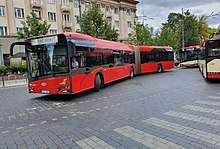
.jpg)
The bus network and the trolleybus network are run by Vilniaus viešasis transportas. There are over 60 bus, 18 trolleybus, 6 rapid bus and 6 night bus routes.[384] The trolleybus network is one of the most extensive in Europe. Over 250 buses and 260 trolleybuses transport about 500,000 passengers every workday.[385] The first regular bus routes were established in 1926, and the first trolleybuses were introduced in 1956.[386]
At the end of 2007, a new electronic monthly ticket system was introduced. It was possible to buy an electronic card in shops and newspaper stands and have it credited with an appropriate amount of money. The monthly e-ticket cards could be bought once and credited with an appropriate amount of money in various ways including the Internet. Previous paper monthly tickets were in use until August 2008.[387]
The ticket system changed again from 15 August 2012. E-Cards were replaced by Vilnius Citizen Cards ("Vilniečio Kortelė"). It is now possible to buy a card or change an old one in newspaper stands and have it credited with an appropriate amount of money or a particular type of ticket. Single trip tickets have been replaced by 30 and 60-minute tickets.
The public transportation system is dominated by the low-floor Volvo and Mercedes-Benz buses as well as Solaris trolleybuses. There are also plenty of the traditional Škoda vehicles, built in the Czech Republic, still in service, and many of these have been extensively refurbished internally. This is a result of major improvements that started in 2003 when the first brand-new Mercedes-Benz buses were bought. In 2004, a contract was signed with Volvo Buses to buy 90 brand-new 7700 buses over the following three years.[388]
An electric tram and a metro system through the city were proposed in the 2000s. However, neither has progressed beyond initial planning.[389] In 2018 the Seimas of the Republic of Lithuania approved a new metro project with the president's agreement.[390]
In 2014 a mobile app was launched with public transport tickets on smartphones.[391]
In 2017, Vilnius started the historically largest upgrade of its buses by purchasing 250 new low-floor buses. The project will result in making 6 of 10 public buses being brand new by the middle of 2018 and will allow its passengers to use such modern technologies as free Wi-Fi and to charge their electronic devices while traveling.[392] On 5 September 2017, 50 new Isuzu buses were presented and articulated Scania buses were promised in the very near future.[393] Vilnius City Municipality also held a contest for 41 new trolleybuses and its winner Solaris committed to deliver all trolleybuses until the autumn of 2018, which will also have the free Wi-Fi and charging features.[394] On 13 November Vilnius City Municipality signed a contract with Solaris for the remaining 150 Solaris Urbino buses of the newest IV generation (100 standard and 50 articulated), also with the free Wi-Fi and USB charging.[395] On 20 September 2019, five all-electric Karsan Jest Electric autobuses were presented, which will serve the 89 route in narrow streets.[396]
Since 2017 a 30-minute ticket costs 0.65 euro, a 60-minute ticket costs 0.90 euro and a single ticket bought on board costs 1.00 euro. There are other types of tickets, both short-term and long-term. Various discounts for pupils, students and elder people are available.[397]
Carsharing and electric vehicles infrastructure
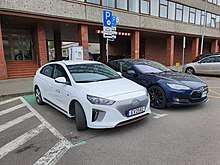
Vilnius-based international company CityBee is the biggest carsharing services provider in Vilnius, which offers cars, bicycles and electric scooters for a short or long term rental. Users get free parking, fuel, insurance and are only required to pay for the time of usage and distance travelled. The rental is activated using a mobile app.[398] Its biggest competitor is another Vilnius-based company SPARK, which works with the same principles, but offers only the electric vehicles and has its own charging stations across Vilnius.[399]
Vilnius is the city with the most electric vehicles in Lithuania.[400] The city has tens of public high-power charging stations, provided by a state-owned enterprise Ignitis ON and a municipal enterprise Susisiekimo paslaugos.[401][402] Vilnius city municipality and the Government of Lithuania encourages the usage of electric vehicles and has granted a number of benefits for such cars users (e.g. six charging stations offers a completely free charging in Vilnius, free parking in the city's public areas,[403] electric vehicles are allowed to drive in a separate A road lane and significantly benefits in the traffic jams,[404] electric and hybrid vehicles license plates begins with a letter E[405]).
Health care
Vilnians took care of the cleanliness and health responsibly already during the Grand Duchy of Lithuania times as the city had public bathhouses and one fourth of houses in Vilnius had individual bathhouses, also almost half of the houses had alcohol distilleries.[406]
The Ministry of Health is located in Vilnius and is responsible for the health care in Lithuania.[407] Vilnians have to pay the compulsory health insurance (6.98% of the salary), which is governed by the Vilnius Territorial Health Insurance Fund and guarantees free health care to every insured person, however some residents are exempt from this tax (e.g. disabled persons, children, full-time students, etc.).[408]
Vilnius University Hospital Santaros Klinikos and the Vilnius City Clinical Hospital are the primary hospitals in Vilnius.[409][410] There also are 8 polyclinics, the Medical Centre of the Ministry of the Interior and a number of private health care facilities in the city.[411]
Media
.jpg)
The first Lithuanian periodical newspaper (weekly) Kurier Litewski was published in Vilnius from 1760 to 1763.[412] Vilnius is home to numerous newspapers, magazines and publications including Lietuvos rytas, Lietuvos žinios, Verslo žinios, Respublika, Valstiečių laikraštis, Mokesčių žinios, Aktualijos, 15min, Vilniaus diena, Vilniaus Kraštas, Lietuvos aidas, Valstybė, Veidas, Panelė, Franciscan Bernardinai.lt, Russian Litovskij kurjer, Polish Tygodnik Wileńszczyzny.[413]
Vilnius TV Tower is located in Karoliniškės microdistrict and transmits television signals to the whole Vilnius.[414] The most-viewed networks in Lithuania are headquartered in Vilnius including LRT televizija, TV3, LNK, BTV, LRT Plius, LRT Lituanica, TV6, Lietuvos rytas TV, TV1, TV8, Sport1, Liuks!, Info TV.[415]
The first stationary radio station in Vilnius Rozgłośnia Wileńska was launched in Žvėrynas microdistrict on 28 November 1927, but was later moved to the present-day Gediminas Avenue in 1935.[416] M-1, the first commercial radio station in Lithuania, started broadcasting from Vilnius in 1989. Many other Lithuanian or foreign languages radio stations also broadcasts from Vilnius, most of them signals comes from the Vilnius TV Tower or the Vilnius Press House.[417]
The Lithuanian Union of Journalists (Lithuanian: Lietuvos žurnalistų sąjunga) and the Lithuanian Society of Journalists (Lithuanian: Lietuvos žurnalistų draugija) are headquartered in Vilnius.[418][419]
Twin towns – sister cities
Vilnius is twinned with:[420]

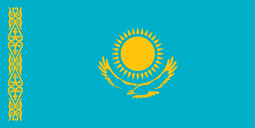
.svg.png)


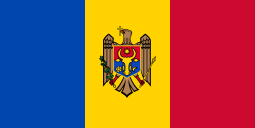



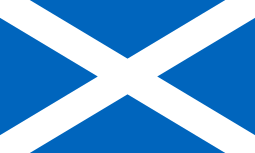















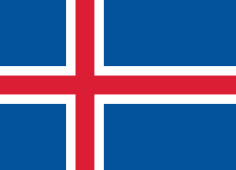









Significant depictions in popular culture
- Vilnius is mentioned in the movie The Hunt for Red October (1990) as being the boyhood home of the sub commander Marko Ramius, and as being where his grandfather taught him to fish; he is also referenced once in the movie as "The Vilnius Schoolmaster". Ramius is played by Sean Connery.
- Author Thomas Harris's character Hannibal Lecter is revealed to be from Vilnius and its aristocracy in the movie Hannibal Rising. Lecter is portrayed more popularly and often by Sir Anthony Hopkins, although Brian Cox played Lecter in the movie Manhunter.
- The memoir A Partisan from Vilna (2010)[421] details the life and struggles of Rachel Margolis. Her family's sole survivor, she escaped from the Vilna Ghetto with other members of the resistance movement, the FPO (United Partisan Organization), and joined the Soviet partisans in the Lithuanian forests to sabotage the Nazis.
- Vilnius is classified as a city-state in the turn-based strategy games Civilization V and "Civilization VI".
- Vilnius is the capital of Lithuania in the turn-based strategy game Medieval II: Total War: Kingdoms and a rebels' town in the Medieval II: Total War game.
- Historical drama War & Peace was filmed in Vilnius by the BBC.
- A well rated five-part historical drama television miniseries about Chernobyl nuclear disaster was mostly filmed in two Soviet-era elderships of Vilnius: Justiniškės and Fabijoniškės.[422]
- HBO's miniseries Catherine the Great, featuring Helen Mirren, was filmed in multiple locations of Vilnius.[423]
- New season of the web television series Stranger Things will be filmed in the now empty Lukiškės Prison in 2020.[424]
Notable people
See also
- Coat of arms of Vilnius
- List of monuments in Vilnius
- List of Vilnius Elderships in other languages
- Neighborhoods of Vilnius
References
- Widespread nickname of Vilnius, that appeared because of a strong Litvak community. Today it is used primarily for the past of the Jewish community of Vilnius, e.g. A book "Vilnius, in search of Jerusalem of Lithuania".
- Widespread use of the nickname from the 16th century to this day as a reference to the many Catholic churches and monasteries in Vilnius and overall religious atmosphere in the centre. This nickname was/is used not only by the foreigners but also by the local population. The 19th-century Lithuanian cultural figure Dionizas Poška nicknamed Vilnius "Rome of the North", as, according to him, Vilnius is "the old religious centre, that transformed from a pagan city into the bastion of Christianity". D. Poška, 'Raštai', Vilnius, 1959, p. 67
- Cultural newspaper, that has been published in Vilnius since 1990, is named "Šiaurės Atėnai" (The Athens of the North) as a reference to one of Vilnius's nicknames, which was widespread in the first half of the 19th century and the first half of the 20th, mostly because of Vilnius University. During the interwar period, a Polish scientific newspaper published in Vilnius was also named "Atheneum Wileńskie".
- Especially in the 16th–17th centuries, Vilnius was called the ‘New Babylon’ because of the many languages spoken there as well as its many religions (there were various Christian communities as well as Jews and a Muslim Tatar community). E.g.: S. Bodniak, "Polska w relacji włoskiej z roku 1604", Pamiętnik biblioteki kórnickiej, 2, (Kórnik, 1930), p. 37.
- This nickname was very popular among the Lithuanian nobility, citizens of Vilnius and poets, especially during the Baroque period. Many poets of the period, including Maciej Kazimierz Sarbiewski, nicknamed Vilnius "the capital of Palemon" or "the city of Palemon". Živilė Nedzinskaitė, Vilnius XVII–XVIII a. LDK lotyniškojoje poezijoje, Acta Academiae Artium Vilnensis, Vilnius, 2010, p. 16; Eugenija Ulčinaitė, Motiejus Kazimieras Sarbievijus: Antikos ir krikščionybės sintezė; Vilniaus pasveikinimas, Lietuvių literatūros ir tautosakos institutas, Vilnius, 2001, pp. 47, 59, 61, 63; etc.
- "Statistinės suvestinės: Gyventojų skaičius pagal savivaldybes 2020 m. sausio 1 d." [Statistical summaries: number of inhabitants in municipalities as of 1 January 2019]. Vilnius (in Lithuanian). Valstybės įmonė Registrų centras [State Enterprise Center of Registers of Lithuania]. 1 January 2020. Retrieved 8 January 2020.
- http://appsso.eurostat.ec.europa.eu/nui/show.do?dataset=urb_lpop1&lang=en
- Vilnius County
- "Statistinių rodiklių analizė". Statistics Lithuania.
- Sub-national HDI. "Area Database – Global Data Lab". hdi.globaldatalab.org.
- "Population on 1 January by age groups and sex – functional urban areas". Eurostat. Retrieved 16 June 2019.
- Health Insurance Fund under the Ministry of Health
- "Lithuania". UNESCO World Heritage Centre. Archived from the original on 14 January 2018.
- Jonathan Steele (19 June 2008). "In the Jerusalem of the North, the Jewish story is forgotten". Opinion. The Guardian. Archived from the original on 14 January 2018. Retrieved 4 March 2018.
- "Ex-Post Evaluation of 2009 European Capitals of Culture" (PDF). ECOTEC Research and Consulting Ltd. Archived (PDF) from the original on 14 January 2018.
- "Portrait of the Regions of Lithuania – Vilnius city municipality". Department of Statistics. Retrieved 1 August 2015.
- Лавринец, Павел (20 October 2004). Русская Вильна: идея и формула. Балканская Русистика (in Russian). Вильнюс. Retrieved 18 August 2009.
- Васютинский, А.М.; Дживелегов, А.К.; Мельгунов, С.П. (1912). "Фон Зукков, По дороге в Вильно". Задруга Французы в России. 1812 г. По воспоминаниям современников-иностранцев. (in Russian). 1–3. Москва. Retrieved 18 August 2009.
- "The Legend of the Founding of Vilnius – Gediminas Dream".
- Tiukšienė, Zita; Sisaitė, Nijolė (2015). Pasižvalgymai po Vilnių (PDF). Vilnius: Adomo Mickevičiaus viešoji biblioteka. p. 167.
- "Vilniaus istorija". vle.lt (in Lithuanian). Retrieved 8 November 2019.
- Rowell, Stephen Christopher (2003). Chartularium Lithuaniae res gestas magni ducis Gedeminne illustrans – Gedimino laiškai (PDF). Vilnius: Leidykla Vaga. Retrieved 7 June 2017.
- "Algirdas". vle.lt. Retrieved 24 April 2020.
- Laimonas Briedis (2008). Vilnius: City of Strangers. Baltos lankos. ISBN 978-9955-23-160-8.
- Given-Wilson, Chris (2016). Henry IV. English Monarchs series. Yale University Press. p. 69. ISBN 978-0300154207.
- Basilevsky, Alexander (2016). Early Ukraine: A Military and Social History to the Mid-19th Century. McFarland. pp. 178–179. ISBN 978-1476620220. Retrieved 11 November 2019.
- "History". Vilnius University. Retrieved 10 July 2019.
- "Vilniaus gynimas". vle.lt. Retrieved 12 November 2019.
- Piotr S. Wandycz, The lands of partitioned Poland, 1795–1918, University of Washington Press, 1974, p. 166.
- Egidijus Aleksandravičius; Antanas Kulakauskas (1996). Carų valdžioje: Lietuva XIX amžiuje [Under the Tzars: Lithuania in the 19th Century] (in Lithuanian). Vilnius: Baltos lankos. Archived from the original on 12 August 2006. Polish translation: Pod władzą carów: Litwa w XIX wieku, Universitas, Kraków 2003, p. 90, ISBN 83-7052-543-1
- Dirk Hoerder; Inge Blank; Horst Rössler (1994). Roots of the Transplanted. East European Monographs. p. 69. ISBN 978-0880332880.
- Joshua D. Zimmerman (2004). Poles, Jews, and the politics of nationality. Univ of Wisconsin Press. p. 16. ISBN 0-299-19464-7.
- Timothy Snyder (2003). The Reconstruction of Nations. Poland, Ukraine, Lithuania, Belarus 1569–1999. Yale University Press. p. 306. ISBN 978-0-300-10586-5.
A 1909 official count of the city found 205,250 inhabitants, of whom 1.2 percent were Lithuanian; 20.7 percent Russian; 37.8 percent Polish; and 36.8 percent Jewish.
- Vardys, Vytas Stanley; Judith B. Sedaitis (1997). Lithuania: The Rebel Nation. Westview Series on the Post-Soviet Republics. WestviewPress. pp. 19–20. ISBN 0-8133-1839-4.
- Eidintas, Alfonsas; Vytautas Žalys; Alfred Erich Senn (1999). Ed. Edvardas Tuskenis (ed.). Lithuania in European Politics: The Years of the First Republic, 1918–1940 (Paperback ed.). New York: St. Martin's Press. pp. 17–18. ISBN 0-312-22458-3.
- "The First German Occupation, 1915–1918" (PDF). Archived (PDF) from the original on 14 January 2018.
- "Lithuania finds lost declaration of independence". World. The Guardian. 30 March 2017. Archived from the original on 14 January 2018.
- Łossowski, Piotr (1995). Konflikt polsko-litewski 1918–1920 (in Polish). Warszawa: Książka i Wiedza. pp. 126–128. ISBN 83-05-12769-9.
- "Prieš 100 metų lenkai užėmė Vilnių: kad jis vėl bus Lietuvos sostine, galėjo tikėti tik don kichotai". Lrt.lt (in Lithuanian). 19 April 2019. Retrieved 22 September 2019.
- Abdelal, Rawi (2001). National Purpose in the World Economy: Post-Soviet States in Comparative Perspective. Cornell University Press. ISBN 978-0-8014-8977-8.
At the same time, Poland acceded to Lithuanian authority over Vilnius in the 1920 Suwałki Agreement.
- Price, Glanville (1998). Encyclopedia of the Languages of Europe. Blackwell Publishing. ISBN 978-0-8014-8977-8.
In 1920, Poland annexed a third of Lithuania's territory (including the capital, Vilnius) in a breach of the Treaty of Suvalkai of 7 October 1920, and it was only in 1939 that Lithuania regained Vilnius and about a quarter of the territory previously occupied by Poland.
- Smith, David James; Pabriks, Artis; Purs, Aldis; Lane, Thomas (2002). The Baltic States. Routledge. ISBN 978-0-415-28580-3.
Fighting continued until the agreement at Suwałki between Lithuania and Poland on 7 October 1920, which drew a line of demarcation which was incomplete but indicated that the Vilnius area would be part of Lithuania
- Eudin, Xenia Joukoff; Fisher, Harold H.; Jones, Rosemary Brown (1957). Soviet Russia and the West, 1920–1927. Stanford University. p. 9. ISBN 978-0-8047-0478-6.
The League effected an armistice, signed at Suwałki, 7 October 1920, by the terms of which the city was to remain under Lithuanian jurisdiction.
- Eidintas, Alfonsas; Tuskenis, Edvardas; Zalys, Vytautas (1999). Lithuania in European Politics. Macmillan. ISBN 978-0-312-22458-5.
The Lithuanians and the Poles signed an agreement at Suwałki on 7 October. Both sides were to cease hostilities and to peacefully settle all disputes. The demarcation line was extended only in the southern part of the front, to Bastunai. Vilnius was thus left on the Lithuanian side, but its security was not guaranteed.
- Abramowicz, Hirsz; Dobkin, Eva Zeitlin; Shandler, Jeffrey; Fishman, David E. (1999). Profiles of a Lost World: Memoirs of East European Jewish Life Before World War II. Wayne State University Press. ISBN 978-0-8143-2784-5.
Before long there was a change of authority: Polish legionnaires under the command of General Lucian Zeligowski 'did not agree' with the peace treaty signed with Lithuania in Suwałki, which ceded Vilna to Lithuania.
- Brecher, Michael; Wilkenfeld, Jonathan (1997). A Study of Crisis. University of Michigan Press. ISBN 978-0-472-10806-0.
Mediation by the League Council led to an agreement on the 20th providing for a cease-fire and Lithuania's neutrality in the Polish–Russian War; Vilna remained part of Lithuania. The (abortive) Treaty of Suwałki, incorporating these terms, was signed on 7 October.
- Buell, Leslie (2007). Poland: Key to Europe. Alfred Knopf, republished by Read Books. ISBN 978-1-4067-4564-1.
Clashes subsequently took place with Polish troops, leading to the armistice at Suwałki in October 1920 and the drawing of the famous Curzon Line under League mediation, which allotted Vilna to Lithuania.
- Slocombe, George (1970). Mirror to Geneva. Ayer Publishing. ISBN 978-0-8369-1852-6.
Zeligowski seized the city in October, 1920, in flagrant violation not only of the Treaty of Suwałki signed by Poland and Lithuania two days earlier, but also of the covenant of the newly created League of Nations.
- Müller, Jan-Werner (2002). Memory and Power in Post-War Europe: Studies in the Presence of the Past. Cambridge University Press. p. 47. ISBN 978-0-5210-0070-3.
- Gross, Jan Tomasz (2002). Revolution from Abroad: The Soviet Conquest of Poland's Western Ukraine and Western Belorussia. Princeton University Press. p. 3. ISBN 978-0-6910-9603-2.
- Tylińska, Ewelina. "The revival of the Vilnius University in 1919: Historical conditions and importance for Polish science". In M. Kokowski (ed.). The Global and the Local: The History of Science and the Cultural Integration of Europe. 2nd ICESHS (Cracow, Poland, September 6–9, 2006). p. 896.
- Iškauskas, Česlovas. "Č. Iškauskas. Galingųjų vizitai Lietuvoje: Napoleonas, Hitleris, Putinas". DELFI. Retrieved 24 September 2019.
- "Kultūrų kryžkelė. Menora (2014.10.30)". Lrt.lt. 30 October 2014. Retrieved 12 November 2019.
- Josef Krauski (1992). "Education as Resistance: The Polish Experience of Schooling During the War". In Roy Lowe (ed.). Education and the Second World War : studies in schooling and social change. Falmer Press. p. 130. ISBN 0-7507-0054-8.
- Praleika, Aidanas. "Pirmoji pasaulyje "gyvybės vizas" žydams išdavė Lietuva, bet pasaulis to nežino". LZinios.lt. Retrieved 15 November 2017.
- Timothy Snyder (2003). The Reconstruction of Nations: Poland, Ukraine, Lithuania, Belarus, 1569–1999. Yale University Press. p. 83. ISBN 978-0-300-12841-3.
- Misiunas, Romuald J.; Rein Taagepera (1993). The Baltic States: Years of Dependence 1940–1990 (expanded ed.). University of California Press. p. 47. ISBN 978-0-520-08228-1.
- Yitzhak Arad, Encyclopedia of the Holocaust, vol. 4, p. 1572
- Anušauskas, Arvydas; et al., eds. (2005). Lietuva, 1940–1990 (in Lithuanian). Vilnius: Lietuvos gyventojų genocido ir rezistencijos tyrimo centras. p. 177. ISBN 978-9986-757-65-8.
- Tourism, Vilnius (1 September 2011). "The Big and Little Ghetto – Vilnius Tourist Information Centre".
- "Mažasis ir Didysis Vilniaus žydų getai" (in Lithuanian). Archived from the original on 3 March 2016.
- Marrus, Michael R. The Holocaust in History. Hanover: University Press of New England, 1987, p. 108.
- Bubnys, Arūnas (1998). Vokiečių okupuota Lietuva (1941–1944). Vilnius: Lietuvos gyventojų genocido ir rezistencijos tyrimo centras. pp. 409–423. ISBN 9986-757-12-6.
- Iškauskas, Česlovas. "1944-ieji: vienus okupantus keitė dar nuožmesni..." DELFI. Retrieved 25 September 2019.
- Piskunowicz, Henryk (1996). "Armia Krajowa na Wileńszczyżnie". In Krzysztof Komorowski (ed.). Armia Krajowa: Rozwój organizacyjny (in Polish). Wydawnictwo Bellona. pp. 213–214. ISBN 83-11-08544-7.
- "Lietuvos vietinė rinktinė" (PDF). genocid.lt. Retrieved 25 September 2019.
- "Kovos dėl Vilniaus 1944 liepą" (in Lithuanian).
- Bubnys, Arūnas. "NKGB–NKVD prieš lenkų pogrindį Lietuvoje 1944 m. antroje pusėje–1945 m. pirmoje pusėje". genocid.lt. Retrieved 25 September 2019.
- "Pokario areštai ir trėmimai (1944–1948 m. pradžia)". lnm.lt (in Lithuanian). Retrieved 25 September 2019.
- "Lietuvos Nepriklausomos Valstybės Atkūrimas (1990 M. Kovo 11 D.)" (in Lithuanian).
- Audrius Siaurusevicius (14 January 1991). "Soviet tanks crush the human shield of Vilnius". World. The Guardian. Archived from the original on 14 January 2018.
- Serge Schmemann (7 September 1991). "Soviet Turmoil; Soviets Recognize Baltic Independence, Ending 51-year Occupation of 3 Nations". The New York Times. Archived from the original on 14 January 2018.
- Number of new flats – record high during the last 10 years (in Lithuanian)
- Construction in Vilnius (in Lithuanian)
- Lithuanian official statistics
- "Cultural capitals of Europe". Chicago Tribune. 11 January 2009. Retrieved 12 January 2009.
- O. Niglio. "Restauri in Lituania. Vilnius Capitale della Cultura Europea 2009" [Restorations in Lithuania. Vilnius Capital of European Culture 2009] (PDF). Web Journal on Cultural Patrimony (in Italian). ISSN 1827-8868.
- Greenhalgh, Nathan. "Capital of Culture: success or failure?". Retrieved 15 May 2011.
- "A.Gelūnas: prokuratūra nusikaltimo rengiant Bjork koncertą neįžvelgė". Retrieved 15 May 2011.
- "Vilnius: artists protest 'breakdown of culture' in EU cultural capital". cafebabel.com.
- Burke, Jason (18 January 2009). "Eastern Europe braced for a violent 'spring of discontent'". The Guardian. London.
- "Balsavimo rezultatai". 2013.vrk.lt. 22 March 2015. Archived from the original on 18 May 2016. Retrieved 26 September 2015.
- "Eastern Partnership Summit in Vilnius begins" (Press release). Ministry of Foreign Affairs of the Republic of Lithuania. 29 November 2013.
- "Strategic Eastern Partnership agreements signed in Vilnius" (Press release). Ministry of Foreign Affairs of the Republic of Lithuania. 29 November 2013.
- "The geographical Centre of Europe". visitlithuania.net. Retrieved 4 November 2019.
- Jan S. Krogh. "Other Places of Interest: Central Europe".
- "The City". City of Vilnius. Archived from the original on 16 December 2008. Retrieved 30 January 2009.
- "Gamtos paveldo apsauga". vilnius.lt. Retrieved 4 November 2019.
- Kottek M, Grieser J, Beck C, Rudolf B, Rubel F (2006). "World Map of the Köppen-Geiger climate classification updated" (PDF). Meteorol. Z. 15 (3): 259–263. Bibcode:2006MetZe..15..259K. doi:10.1127/0941-2948/2006/0130.
- Raymond S. Bradley; Philip D. Jones (1995). Climate Since A.D. 1500. Routledge. ISBN 978-0-415-12030-2.
- "Climate change in Lithuania". Lithuanian Hydrometeorological Service under the Ministry of Environment. Archived from the original on 19 August 2014. Retrieved 18 August 2014.
- "Lithuanian Hydrometeorological Service". meteo.lt. Retrieved 7 August 2020.
- "World Weather Information Service – Vilnius". World Meteorological Organization. Retrieved 2 February 2013.
- "Vilnius Climate Normals 1961–1990". National Oceanic and Atmospheric Administration. Retrieved 2 February 2013.
- "Météo Climat 1981–2010 averages for Lithuania". Météo Climat. Retrieved 15 October 2017.
- d.o.o, Yu Media Group. "Vilnius, Lithuania - Detailed climate information and monthly weather forecast". Weather Atlas. Retrieved 6 July 2019.
- "Lietuvos tapyba". vle.lt (in Lithuanian). Retrieved 10 November 2019.
- "Lietuvos skulptūra". vle.lt (in Lithuanian). Retrieved 10 November 2019.
- "Vilniaus meno mokykla". alka.mch.mii.lt. Retrieved 10 November 2019.
- "Lietuvių dailės draugija". vle.lt. Retrieved 10 November 2019.
- "Vilniaus dailės draugija". vle.lt. Retrieved 10 November 2019.
- "Collections". ldm.lt. Retrieved 10 November 2019.
- "Permanent exhibitions". ldm.lt. Retrieved 10 November 2019.
- "Collection". ndg.lt. Retrieved 10 November 2019.
- "About the CAC". cac.lt. Retrieved 10 November 2019.
- "About us". mekas.lt. 25 July 2014. Retrieved 10 November 2019.
- "About MO". mo.lt. Retrieved 23 April 2019.
- Joanna Griffin (8 August 2016). "Just Back: Inside Uzupis, Lithuania's free-thinking republic". Travel. The Telegraph. Archived from the original on 14 January 2018.
- "Frank Zappa Memorial". lonely planet.
- "Vilnius Talking Statues". vilnius-tourism.lt. 19 June 2015. Retrieved 10 November 2019.
- "Biography of Skaryna". web1.mab.lt. Retrieved 29 October 2019.
- "Vilnius University Press – History". vu.lt. Retrieved 29 October 2019.
- "Zawadzkio spaustuvė". vle.lt. Retrieved 29 October 2019.
- "Adomas Mickevičius". vle.lt. Retrieved 30 October 2019.
- Lebedys, Jurgis. "Mikalojus Daukša". postilla.mch.mii.lt. Retrieved 29 October 2019.
- "Vilnius University Hinc Itur Ad Astra" (PDF). 20 October 2015: 25. Retrieved 29 October 2019. Cite journal requires
|journal=(help) - "Lietuvos Statutas". vle.lt. Retrieved 29 October 2019.
- Dubonis, Artūras. "Lietuvių kalba: poreikis ir vartojimo mastai (XV a. antra pusė – XVI a. pirma pusė)". viduramziu.istorija.net (in Lithuanian). Retrieved 22 September 2019.
- "Lietuvos Metrika". vle.lt. Retrieved 30 October 2019.
- "Literatų Gatvė (Literature Street)". atlasobscura.com. Retrieved 17 November 2019.
- "About". llti.lt. Retrieved 29 October 2019.
- "Lithuanian Writers Union". rasytojai.lt. Retrieved 29 October 2019.
- "Vilnius Book Fair". vilniausknygumuge.lt. Retrieved 2 November 2019.
- "Vilniaus kino istorija: pirmasis seansas tik pusmečiu atsiliko nuo pirmojo istorijoje". Lrt.lt (in Lithuanian). 27 November 2015. Retrieved 22 September 2019.
- "Vilniaus kino teatrai 1905–1985 metais". MadeinVilnius.lt (in Lithuanian). 1 May 2017. Retrieved 22 September 2019.
- "Vilniuje neliko istorinio kino teatro "Lietuva"". 15min.lt (in Lithuanian). Retrieved 22 September 2019.
- "About Festival". kinopavasaris.lt. Retrieved 14 October 2019.
- "About us". lkc.lt. Retrieved 22 September 2019.
- "Operą Vilnius išvydo pirmiau negu Londonas ir Paryžius". valdovurumai.lt. 12 April 2011. Retrieved 26 April 2020.
- "Žygimantas Liauksminas". vle.lt. Retrieved 23 January 2020.
- "Operos dieną Valdovų rūmuose vainikuos pasaulinis šedevras – K. Monteverdžio opera "Orfėjas"". valdovurumai.lt. Retrieved 7 September 2015.
- "Repertoire". opera.lt. Retrieved 31 October 2019.
- "History – Largest Concert Institution in Lithuania". Lithuanian National Philharmonic Society. Retrieved 3 February 2017.
- "About us". lvso.lt. Retrieved 31 October 2019.
- Murauskaitė, Rasa. "Trys meilės chorui dešimtmečiai. Pokalbis su Vaclovu Augustinu". 15min.lt (in Lithuanian). Retrieved 31 October 2019.
- "Lithuanian Song Festival". DainuSvente.lt. Retrieved 23 January 2018.
- Masterpieces of the Oral and Intangible Heritage of Humanity (PDF). UNESCO. 2005. p. 50.
- "Jazz in Lithuania". Vilniusjazz.lt. Retrieved 25 March 2018.
- "Street Music Day". gmd.lt. Retrieved 10 March 2018.
- "Dainavimo katedra". lmta.lt (in Lithuanian). Retrieved 31 October 2019.
- "Seniausių laikų Lietuvos teatras". vle.lt. Retrieved 17 November 2019.
- "Mokyklinis teatras Lietuvos teritorijoje". vle.lt. Retrieved 17 November 2019.
- "Lietuvos teatras". vle.lt. Retrieved 17 November 2019.
- "Vilniaus miesto teatras". vle.lt. Retrieved 17 November 2019.
- "Juliusz Osterwa". vle.lt. Retrieved 24 December 2019.
- "Events". teatrai.lt. Retrieved 17 November 2019.
- "Lituanistica". lietuvos.istorija.net. Retrieved 26 June 2017.
- "Raštas ir kalbos viduramžių Lietuvoje". viduramziu.istorija.net (in Lithuanian). Retrieved 22 September 2019.
- Pancerovas, Dovydas. "Ar perrašinėjamos istorijos pasakų įkvėpta Baltarusija gali kėsintis į Rytų Lietuvą?". 15min.lt (in Lithuanian). Retrieved 1 October 2014.
- Statkuvienė, Regina. "Jogailaičiai. Kodėl ne Gediminaičiai?". 15min.lt (in Lithuanian). Retrieved 9 November 2018.
- Zinkevičius, Zigmas. "Lietuvos Didžiosios Kunigaikštystės kanceliarinės slavų kalbos termino nusakymo problema". viduramziu.istorija.net (in Lithuanian). Retrieved 22 September 2019.
- "Žydų padėtis LDK". zydai.lt (in Lithuanian). Retrieved 22 September 2019.
- "Valstybinės kalbos teisinė informacija". vilnius.lt (in Lithuanian). Retrieved 22 September 2019.
- "Employees fluent in three languages – it's the norm in Lithuania". investlithuania.com. Retrieved 6 November 2019.
- "Vilniečiai mėgo meną, puoštis ir išgerti". bernardinai.lt (in Lithuanian). Retrieved 27 January 2020.
- Ragauskas, Aivas. "LDK istorija: Miestiečių apranga". 15min.lt (in Lithuanian). Retrieved 27 January 2020.
- "Drabužiai". vle.lt. Retrieved 27 January 2020.
- "Fashion Infection". madosinfekcija.lt. Retrieved 27 January 2020.
- "J.Statkevičius Vilniuje pristatė savo 2020 m. šiltojo sezono kolekciją: kuo nustebino dizaineris?". 15min.lt (in Lithuanian). Retrieved 27 January 2020.
- "Valstybinės šventės". vilnius-tourism.lt (in Lithuanian). 1 September 2011. Retrieved 14 October 2019.
- "Vasario 16-osios renginių programa". madeinvilnius.lt (in Lithuanian). 28 January 2019.
- "Ką veikti kovo 11-ąją Vilniuje?". madeinvilnius.lt (in Lithuanian). 11 March 2018. Retrieved 14 October 2019.
- Jačauskas, Ignas. "Vilniuje pagerbiant žuvusius Sausio 13-ąją uždegti atminimo laužai". 15min.lt (in Lithuanian). Retrieved 14 October 2019.
- "Kaziuko mugė". kaziukomuge.lt. Retrieved 14 October 2019.
- ""Sostinės dienų 2019" programa". vilnius.lt (in Lithuanian). 22 August 2019. Retrieved 14 October 2019.
- "Švento Patriko dieną Vilnelė vėl nusidažys žaliai". madeinvilnius.lt (in Lithuanian). 13 March 2019. Retrieved 14 October 2019.
- Antanas Rimvydas Čaplinskas. "Vilniaus istorija: kas vadovavo miestui?". klaipeda.diena.lt. Retrieved 21 March 2010.
- "History". vilniausrotuse.lt. Retrieved 31 October 2019.
- "Magistratas". vle.lt. Retrieved 5 November 2019.
- "Vaitas". vle.lt. Retrieved 5 November 2019.
- "Vilniaus miesto savivaldybės istorija". lrvalstybe.lt. Retrieved 2 November 2019.
- "Elections". vrk.lt. Retrieved 23 April 2019.
- Pocytė, Kristina (18 March 2019). "Lithuania makes its choice: odd unions raise some, side-line others". Delfi: The Lithuania Tribune. Lithuania. Retrieved 16 April 2019.
R. Šimašius to remain as mayor in Vilnius for another term
- "Vilniaus seniūnijos". vilnius.lt (in Lithuanian). Retrieved 7 July 2019.
- "Medininkai Castle". exploretrakaivilnius.lt. Retrieved 14 August 2019.
- "Vilnius District Municipality – About Us". vrsa.lt. Retrieved 14 August 2019.
- "Vilniaus verbos – spalvingiausios". diena.lt (in Lithuanian). Retrieved 29 August 2019.
- "Paulavos respublika". vle.lt. Retrieved 29 January 2020.
- "Vilniaus rajono savivaldybės taryba (rezultatai 2019 m.)". vrk.lt. Retrieved 14 August 2019.
- "Mayor". vrsa.lt. Retrieved 14 August 2019.
- "Presidential Palace". lrp.lt. Retrieved 3 July 2019.
- "Kaip mus rasti?". lrvk.lrv.lt (in Lithuanian). Retrieved 3 July 2019.
- "Lietuvos Respublikos Prezidentas – Rezidencija". archyvas.lrp.lt. Retrieved 3 July 2019.
- "I-56 Lietuvos Respublikos Prezidento įstatymas". e-seimas.lrs.lt. Retrieved 3 July 2019.
- "Skvernelis su šeima persikraustė į rezidenciją Turniškėse". DELFI. Retrieved 1 July 2019.
- "Ministries of Lithuania". lrv.lt (in Lithuanian). Retrieved 3 July 2019.
- "Seimas of the Grand Duchy of Lithuania before 1569". lrs.lt. Retrieved 30 October 2019.
- "Parliament of the Republic of Lithuania". lrs.lt. Retrieved 3 July 2019.
- "About the Court". lat.lt. Retrieved 3 July 2019.
- "The Court". lvat.lt.
- "Constitutional Court of The Republic of Lithuania". lrkt.lt. Retrieved 3 July 2019.
- "Istorija". lat.lt (in Lithuanian). Retrieved 11 July 2019.
- "Veiklos sritys". vilnius.policija.lrv.lt (in Lithuanian). Retrieved 2 July 2019.
- "L. Pernavas: Vilniuje dirba 1 tūkst. 500 policininkų". DELFI. Retrieved 28 September 2016.
- "Veiklos sritys". vstarnyba.lrv.lt (in Lithuanian). Retrieved 2 July 2019.
- "Vilniaus apskrities priešgaisrinė gelbėjimo valdyba". vilnius.ugniagesiai.lrv.lt. Retrieved 2 July 2019.
- "2018 metų devynių mėnesių gaisrų ir gelbėjimo darbų statistika Vilniaus mieste" (PDF). vilnius.ugniagesiai.lrv.lt. Retrieved 2 July 2019.
- "Viešoji įstaiga Greitosios medicinos pagalbos stotis". vgmps.lt. Retrieved 2 July 2019.
- "Apie mus". vgmps.lt (VGMPS). Retrieved 2 July 2019.
- "112 – Skubi Pagalba". 112.lt. Retrieved 2 July 2019.
- "Vilnius Historic Centre". unesco.org. Retrieved 12 August 2019.
- "The capital – Vilnius". lithuania.travel. Retrieved 12 August 2019.
- Bideleux, Robert; Jeffries, Ian (1998). A history of Eastern Europe: crisis and change. Routledge. p. 122. ISBN 978-0415161114.
- "Gotika". iVilnius.lt. Retrieved 12 August 2019.
- "Renesansas". iVilnius.lt. Retrieved 12 August 2019.
- "Barokas". iVilnius.lt. Retrieved 12 August 2019.
- "Klasicizmas". iVilnius.lt. Retrieved 12 August 2019.
- "Vilniaus architektūra". vle.lt. Retrieved 12 August 2019.
- "Ar žinojote, kad Vilniaus barokinės architektūros perlus sukūrė šveicarai, o ne italai?". lrytas.lt (in Lithuanian). Retrieved 28 August 2019.
- "Laurynas Gucevičius: kaip formavosi žymiausio architekto vardas". ldkistorija.lt. Retrieved 28 August 2019.
- "Vilnius. Šeškinė. Monolitiniai akcentai šalia kalvoto ozo". DELFI. Retrieved 12 August 2019.
- "Sostinės Žirmūnai – masinės gyvenamųjų namų statybos pavyzdys". sa.lt (in Lithuanian). 25 October 2016. Retrieved 12 August 2019.
- "Pažintis su sostinės Justiniškėmis: kaimas, tapęs vienu tankiausių gyvenamųjų rajonų". sa.lt (in Lithuanian). 22 October 2016. Retrieved 12 August 2019.
- Kirilova, Patricija. "Turėjo būti seniai nugriauti, bet stovi iki šiol: kas laukia gyvenančių senos statybos daugiabučiuose?". DELFI. Retrieved 12 August 2019.
- "About Vilnius". vaspvt.gov.lt. Retrieved 12 August 2019.
- "Crypts". bpmuziejus.lt. Retrieved 3 October 2019.
- "Patraukliausi Vilniaus rajonai". asa.lt (in Lithuanian). Retrieved 13 August 2019.
- "Flats in Vilnius Senamiestis and Užupis". aruodas.lt. Retrieved 13 August 2019.
- "Mikrorajonai". iVilnius.lt. Retrieved 13 August 2019.
- "Houses in Vilnius Valakampiai and Turniškės". aruodas.lt. Retrieved 13 August 2019.
- "Keičiasi renovacijos rėmimo tvarka". renovacija.lt. Retrieved 13 August 2019.
- "Šilti namai ne visur: kodėl kai kurios savivaldybės neskuba atnaujinti daugiabučių?". alfa.lt (in Lithuanian). Retrieved 13 August 2019.
- "Didmiesčiai liko be naujų renovacijos planų". vz.lt (in Lithuanian). Retrieved 7 October 2019.
- "Prestižiniai Vilniaus rajonai: ar išlaikys miestiečių išbandymą?". 15min.lt (in Lithuanian). Retrieved 13 August 2019.
- "Šnipiškės. Nuo skurdaus priemiesčio iki patogaus centro". 15min.lt (in Lithuanian). Retrieved 31 August 2019.
- Šnipiškių dalis, vad. Skansenu(in Lithuanian)
- Šnipiškių dalis, vad. Piromontu(in Lithuanian)
- "Statyba ir architektūra", 1964, 2, pp. 1–2
- articles in "Statyba ir architektūra", 1964, 11
- "Statyba ir architektūra", 1973, 8, pp. 1–3
- "Lietuvos TSR istorijos ir kultūros paminklų sąvadas. 1 dalis Vilniaus paminklai", 1988, 383. Naujasis miesto centras; pp. 506–509
- Marija Drėmaitė, "Baltic modernism Architecture and housing in soviet Lithuania", pp. 220–224,
- "Vilniaus naujojo miesto centro transformacijos". sa.lt (in Lithuanian). 13 September 2018. Retrieved 31 August 2019.
- Grigaliūnaitė, Violeta. "Vilniaus centre – japoniško sodo nesulaukianti teritorija su ežerėliu". 15min.lt (in Lithuanian). Retrieved 31 August 2019.
- "Price statistics". aruodas.lt. Retrieved 13 August 2019.
- "Vilniuje būsto įperkamumas ir butų sandorių skaičius muša rekordus". swedbank.lt (in Lithuanian). Retrieved 13 August 2019.
- "Tyrimas: lietuviai tėvų namus palieka vėliausiai Baltijos šalyse". swedbank.lt (in Lithuanian). Retrieved 13 August 2019.
- "Gediminaičiai". vle.lt. Retrieved 14 January 2020.
- "Karaliaus Mindaugo portretui faktų vis dar stinga". vz.lt (in Lithuanian). Retrieved 14 January 2020.
- "Laiko ženklai. Didikai Vilniuje". Lrt.lt (in Lithuanian). 15 October 2005. Retrieved 14 January 2020.
- Jokubauskas, Vytautas. "Lietuvos aukso amžius – vienas sprendimas galėjo pakeisti visą istoriją". DELFI (in Lithuanian). Retrieved 15 January 2020.
- "Lietuvos Didžiosios Kunigaikštystės gyventojai". vle.lt (in Lithuanian). Retrieved 14 January 2020.
- "Lietuvos gyventojai Rusijos imperijos valdymo metais (1795–1914)". vle.lt (in Lithuanian). Retrieved 14 January 2020.
- Janušauskienė, Diana (1 October 2012). "Tolerancijos apraiškos Lietuvoje: vertybinės nuostatos tautinių mažumų atžvilgiu" (PDF): 426. Retrieved 14 January 2020. Cite journal requires
|journal=(help) - "Lietuvos gyventojai Pirmojo pasaulinio karo metais (1914–1918)". vle.lt. Retrieved 14 January 2020.
- "Lietuvos Respublikos gyventojai (1918–1940)". vle.lt. Retrieved 14 January 2020.
- "Gyventojų skaičius pagal savivaldybes 2020 m. sausio 1 d." (PDF). registrucentras.lt. Retrieved 14 January 2020.
- Первая всеобщая перепись населения Российской Империи 1897 г. – Вильна [First general census of the Russian Empire in 1897 – Vilna] (in Russian).
- Der Große Brockhaus. 15th edition, vol. 20, Leipzig 1935, pp. 347–348.
- Timothy Snyder (2003). The Reconstruction of Nations: Poland, Ukraine, Lithuania, Belarus, 1569–1999. Yale University Press. pp. 92–93. ISBN 978-0-300-10586-5.
- "Gyventojai [Population]" (PDF). Statistics Department of Lithuania. Archived from the original (PDF) on 17 April 2012.
- Lietuvos gyventojai 2011 metais (2011 m. gyventojų surašymo rezultatai / Lithuanian 2011 Population Census in Brief) [Population of Lithuania in 2011 (Population Census 2011 results)]. Statistics Department of Lithuania. ISBN 978-9955-797-17-3. Retrieved 11 March 2019.
- "Vilniaus tautos". quest.lt (in Lithuanian). Retrieved 20 January 2020.
- "Vilniaus konfesinė įvairovė". ldkistorija.lt. Retrieved 20 January 2020.
- "Vytautas Didysis". vle.lt. Retrieved 20 January 2020.
- Baronas, Darius. "LDK istorija: Lietuviai bizantiečių akimis". 15min.lt (in Lithuanian). Retrieved 20 January 2020.
- Butkus, Alvydas (2011). Baltų tautinio sąmonėjimo skirtumai ir jų įtaka dabarties politikai. Vilnius: Lithuanian Academy of Sciences. p. 99. Retrieved 20 January 2020.
- "Abiejų Tautų tarpusavio įžadas". vle.lt (in Lithuanian). Retrieved 20 January 2020.
- Janušauskienė, Diana (1 October 2012). "Tolerancijos apraiškos Lietuvoje: vertybinės nuostatos tautinių mažumų atžvilgiu" (PDF): 425. Retrieved 14 January 2020. Cite journal requires
|journal=(help) - Juozas Jurginis; Vytautas Merkys; Adolfas Tautavičius (1968). Vilniaus miesto istorija [Vilnius city history] (in Lithuanian). Vilnius. p. 303.
- Janušauskienė, Diana (1 October 2012). "Tolerancijos apraiškos Lietuvoje: vertybinės nuostatos tautinių mažumų atžvilgiu" (PDF): 427. Retrieved 14 January 2020. Cite journal requires
|journal=(help) - Crowe, David (1993). The Baltic States And The Great Powers: Foreign Relations, 1938–1940. Routledge. ISBN 978-1-00-031480-9. Retrieved 20 January 2020.
- "Bendrasis vidaus produktas pagal apskritis 2018 m." osp.stat.gov.lt.
- "OECD Regional Economy, USD per Head, Constant prices, Constant PPP, base year 2015". stats.oecd.org.
- https://vilnius.lt/lt/2020/01/22/planuojamas-2020-m-vilniaus-miesto-biudzetas-11-proc-didesnis-nei-pernai/
- "Darbo užmokestis apskrityse ir savivaldybėse" [Salaries in counties and municipalities] (in Lithuanian). Statistics Lithuania. p. . Retrieved 3 December 2019.
- Country Report Lithuania 2019 (PDF). Brussels: European Commission. 27 February 2019. p. 8. Retrieved 2 July 2019.
- "Biurų pastatui Konstitucijos prospekte suteiktas aukščiausias Baltijos šalyse tvarumo įvertinimas". 15min.lt (in Lithuanian). Retrieved 31 August 2019.
- Country Report Lithuania 2019 (PDF). Brussels: European Commission. 27 February 2019. p. 9. Retrieved 2 July 2019.
- Country Report Lithuania 2019 (PDF). Brussels: European Commission. 27 February 2019. p. 10. Retrieved 2 July 2019.
- Country Report Lithuania 2019 (PDF). Brussels: European Commission. 27 February 2019. p. 22. Retrieved 2 July 2019.
- Country Report Lithuania 2019 (PDF). Brussels: European Commission. 27 February 2019. p. 42. Retrieved 2 July 2019.
- "Vilnius Industrial Park". investmentpartner.lt. Retrieved 31 August 2019.
- "About us". ssmtp.lt. Retrieved 25 September 2019.
- "About us". ftmc.lt. Retrieved 25 September 2019.
- ""Open House Vilnius" open architecture weekend". ftmc.lt. Retrieved 25 September 2019.
- "FTMC announces an annual Conference". ftmc.lt – FizTech 2018. Retrieved 25 September 2019.
- "Research center". fimtp.lt. Retrieved 25 September 2019.
- "Apie". lasercenter.vu.lt.
- "Lietuviai pagamino vieną galingiausių lazerių pasaulyje". DELFI. Retrieved 26 September 2019.
- "Lithuanian R&D company signs major deal with US market leader". investlithuania.com. Retrieved 5 October 2019.
- "Kas mes". gmc.vu.lt (in Lithuanian). Retrieved 25 September 2019.
- "Technologinis verslo inkubatorius". gmc.vu.lt (in Lithuanian). Retrieved 25 September 2019.
- "Research Centres". vgtu.lt. Retrieved 25 September 2019.
- "About LSRC". lstc.lt. Retrieved 2 October 2019.
- "R&D areas". santarosslenis.eu. Retrieved 5 October 2019.
- ""Santaros" slėnyje duris atvers VU Medicinos fakulteto mokslo centras". naujienos.vu.lt. Retrieved 5 October 2019.
- "Iš Vilniaus universiteto istorijos, 1955–1990" (PDF). 5 November 1995: 1–2. Cite journal requires
|journal=(help) - "Vilniaus astrofotometrinė sistema". vle.lt. Retrieved 26 October 2019.
- Giorgia Guglielmi (31 May 2015). "Million-dollar Kavli prize recognizes scientist scooped on CRISPR". Nature. 558 (7708): 17–18. doi:10.1038/d41586-018-05308-5. PMID 29872189.
- "Kaip informacinės technologijos keičia Lietuvą". lrytas.lt (in Lithuanian). 25 October 2018. Retrieved 24 September 2019.
- "Faculty of Mathematics and Informatics". mif.vu.lt. Retrieved 24 September 2019.
- "Faculty of Fundamental Sciences". vgtu.lt. Retrieved 24 September 2019.
- "Didžiausi atlyginimai Lietuvoje: pirmoje vietoje – nesuvokiama suma". tv3.lt. Retrieved 24 September 2019.
- Information technologies in Lithuania (2018 ed.). Vilnius: Department of Statistics (Lithuania). p. 8.
- "About". vilniustechpark.lt. Retrieved 24 September 2019.
- Irwin-Hunt, Alex. "Tech Start-up FDI Attraction Index 2019". fdiintelligence.com. Retrieved 21 October 2019.
- "Vilniuje internetas greičiausias pasaulyje". DELFI. Retrieved 24 September 2019.
- "Monthly comparisons of internet speeds from around the world". speedtest.net. Retrieved 24 September 2019.
- "Vilniaus oro uosto internetas – vienas greičiausių Europoje". investlithuania.com (in Lithuanian). Retrieved 24 September 2019.
- "Veiklą pradeda Nacionalinis kibernetinio saugumo centras". DELFI. Retrieved 24 September 2019.
- "Apie Bebrą". bebras.lt. Retrieved 24 September 2019.
- "Lietuvos mokyklose – pirmoji nuo pradinių klasių programuoti mokančių vaikų karta". DELFI. Retrieved 24 September 2019.
- "Lithuania sees flood of fintech firms apply for licences ahead of Brexit". Reuters. 8 February 2019. Retrieved 5 October 2019.
- "Google grupės įmonei Lietuvoje suteikta elektroninių pinigų įstaigos licencija". lb.lt (in Lithuanian). Retrieved 22 October 2019.
- ""Revolut" nesikrausto – klientus perkelia į lietuvišką įmonę". 15min.lt (in Lithuanian). Retrieved 22 October 2019.
- Zalanskaite, Agne (8 February 2018). "Europe's First International Blockchain Centre Launches in Vilnius". bcgateway.eu. Retrieved 5 October 2019.
- "Competence Areas". finmin.lrv.lt (in Lithuanian). Retrieved 31 August 2019.
- "Mission, vision, values". lb.lt. Retrieved 31 August 2019.
- "Nasdaq Vilnius". nasdaqbaltic.com. Retrieved 31 August 2019.
- "Vision Mission and Strategic Goal, Values". vkontrole.lt.
- "Public services". vmi.lt. Retrieved 31 August 2019.
- "Banks". lb.lt. Retrieved 31 August 2019.
- "Lietuvos bankas: kaistanti NT rinka ir priklausomybė nuo Šiaurės šalių bankų kelia riziką". lrt.lt (in Lithuanian). 13 June 2019. Retrieved 31 August 2019.
- "Facts and Figures". Retrieved 23 April 2019.
- "Breaking News for Lithuania: VU – Among the Top 500 Universities in the World". Vilnius University. 7 September 2016. Archived from the original on 21 November 2016. Retrieved 2 February 2017.
- "Programmes in English". Vilnius University. Retrieved 5 March 2018.
- "About MRU". mruni.eu. Retrieved 23 April 2019.
- "About University". vgtu.lt. Retrieved 23 April 2019.
- "History". svietimas.vdu.lt. Retrieved 23 April 2019.
- "Vilnius Art Academy Museum". muziejai.lt. Retrieved 2 February 2017.
- "Lithuania Overview". eacea.ec.europa.eu. 9 October 2017. Retrieved 2 November 2019.
- "Istorija". vytautodidziojo.vilnius.lm.lt (in Lithuanian). Retrieved 2 November 2019.
- Lietuvos švietimas skaičiais (PDF). Vilnius: Švietimo informacinių technologijų centras. 2018. pp. 65–74.
- "Paskelbti geriausių šalies mokyklų ir universitetų reitingai". Lrt.lt (in Lithuanian). 8 May 2019. Retrieved 2 November 2019.
- Lietuvos tautinių mažumų švietimo būklės analizė (PDF). NMVA Švietimo politikos analizės skyrius. 2018. pp. 8 & 11.
- "Profesinės mokyklos Vilniuje". studijos.lt. Retrieved 2 November 2019.
- "Population with tertiary education". OECD. Retrieved 2 November 2019.
- Mačiulytė-Kasperavičienė, Audronė (1979). Vilniaus universiteto rūmai. Vilnius: Vaga. p. 112.
- "Mission and vision". vcb.lt. Retrieved 10 July 2019.
- "Libraries". vcb.lt. Retrieved 10 July 2019.
- "Kompiuterinio raštingumo kursai". vcb.lt (in Lithuanian). Retrieved 10 July 2019.
- "Paid and free services". vcb.lt. Retrieved 10 July 2019.
- "Misija ir tikslai". lnb.lt (in Lithuanian). Retrieved 10 July 2019.
- "LNB elektroninis katalogas". lnb.lt (in Lithuanian). Retrieved 10 July 2019.
- "About the Library". mab.lt. Retrieved 10 July 2019.
- "Scholarly Communication and Information Centre (SCIC)". biblioteka.vu.lt. Retrieved 10 July 2019.
- "Unikalios architektūros, moderni Vilniaus universiteto biblioteka atveria duris". naujienos.vu.lt (in Lithuanian). Retrieved 10 July 2019.
- "Central Library". biblioteka.vu.lt. Retrieved 10 July 2019.
- "Lietuvos bibliotekos". vle.lt. Retrieved 27 January 2020.
- "Gyventojai pagal religinę bendruomenę, kuriai jie save priskyrė, savivaldybėse" [Residents according to the religious community they attributed themselves to, by municipalities] (.xls) (in Lithuanian). Statistics Lithuania. 15 March 2013. Retrieved 14 May 2016.
- Samuel Lewkenor, A discovrse not altogether vnprofitable, nor vnpleasant for such as are desirous to know the situation and customes of forraine Rities without trauelling to see them. Containing a Discourse of all those Rities wherein doe flourish at this day priuiledged vniuersities. Written by Samvuel Levvkenor, Gentleman (London, 1600)
- Robert Morden, Geography Rectified or a Description of the World (London, 1688), p. 117: "Vilna, the Capital City, incloses so many sorts of Religions, that there is no City in the World where God is Worshipped after so many different ways, unless in Amsterdam; a Liberty too much allowed in most parts of Christendom, but rare temporum felicitas"
- Gintautas Sliesoriūnas, "The image of Lithuania in XVII c. English publications", Lithuanian Historical Studies, 2011, vol. 16
- Geggel, Laura (1 August 2015). "Remains of Nazi-Destroyed Synagogue Found Using Radar". Live Science. livescience.com. Retrieved 25 May 2018.
- Geggel, Laura (3 August 2015). "Remains of Synagogue Destroyed by Nazis Found With Radar". Live Science. Retrieved 4 August 2015 – via nbcnews.com.
- Tapani Harviainen (1997). "New Life in Karaim Communities". In M'Hammed Sabour; Knut S. Vikør (eds.). Ethnic encounter and cultural change : papers from the Third Nordic Conference on Middle Eastern Studies, Joensuu, 1995. Euronet.nl. Bergen: Nordic Society for Middle Eastern Studies. pp. 72–83. ISBN 1850653119. Archived from the original on 3 April 2009. Retrieved 6 May 2009.
- "Religion by Location". Adherents.com. Retrieved 6 May 2009.
- Gabriel Ignatow (2007). Transnational Identity Politics and the Environment. Lexington Books. ISBN 978-0-7391-2015-6.
- "Ką perskaitysime šv. Jono Pauliaus II gyvenimo knygoje?". vaticannews.va (in Lithuanian). 2 May 2018. Retrieved 6 October 2019.
- "Apie mus". piligrimyste.lt (in Lithuanian). Retrieved 24 September 2019.
- "Pilgrimage in Vilnius". vilnius-tourism.lt. 20 August 2018. Retrieved 24 September 2019.
- "The House of St. Faustina". gailestingumas.com. Retrieved 24 September 2019.
- "Senąją Lukiškių Dievo Motinos ikoną atidengiant". bernardinai.lt. Retrieved 24 September 2019.
- "Restauruota Lukiškių Dievo Motinos ikona grąžinama dominikonams". DELFI. Retrieved 24 September 2019.
- Gidžiūnas, Viktoras (1955). "Legendariškieji pranciškonų kankiniai Vilniuje". Aidai.eu (in Lithuanian). 10. ISSN 0002-208X.
- "Vilnius Calvary. Origins". vilniauskalvarijos.lt. Retrieved 3 October 2019.
- "Traditions of Piety". vilniauskalvarijos.lt. Retrieved 3 October 2019.
- "The route of Christ's suffering". vilniauskalvarijos.lt. Retrieved 3 October 2019.
- "20th – 21st centuries". vilniauskalvarijos.lt. Retrieved 3 October 2019.
- "Bendruomeninis Kryžiaus kelio apvaikščiojimas". vilniauskalvarijos.lt. Retrieved 3 October 2019.
- "Treasury". bpmuziejus.lt.
- Garškaitė, Rosita. "Kaip popiežiaus atvykimui ruošiasi latviai ir estai?". bernardinai.lt. Retrieved 24 September 2019.
- "Vilniuje vartus atvėrė restauruotas Bernardinų sodas" [The renovated Bernardinai Garden opened its gates in Vilnius]. Suprasti Akimirksniu (in Lithuanian).
- "Užupis Old Jewish Cemetery [Užupio Senosios Žydų Kapinės]". In Your Pocket. Retrieved 5 September 2012.
- "City Tourism Statistics". vilnius-tourism.lt. 30 August 2011. Retrieved 14 August 2019.
- "Vilniaus miesto turizmo tyrimas ir turistų pasitenkinimo indeksas" (PDF). 2018: 10–11. Retrieved 14 August 2019. Cite journal requires
|journal=(help) - "Vilniaus miesto turizmo tyrimas ir turistų pasitenkinimo indeksas" (PDF). 2018: 12–14. Retrieved 14 August 2019. Cite journal requires
|journal=(help) - "Apsipirkti į Lietuvą miniomis traukia ne eiliniai baltarusiai". DELFI. Retrieved 15 August 2019.
- "Vilniaus miesto turizmo tyrimas ir turistų pasitenkinimo indeksas" (PDF). 2018: 26. Retrieved 14 August 2019. Cite journal requires
|journal=(help) - "City Costs Barometer 2019" (PDF). postoffice.co.uk. Retrieved 22 October 2019.
- "D. Matulionis: džiugu, kad pavyko sutarti mūsų valstybei ir Lietuvos žydų bendruomenei svarbiu klausimu". lrv.lt (in Lithuanian). Retrieved 28 December 2019.
- "Lithuania". hotelstars.eu. Retrieved 14 August 2019.
- "5 stars hotels in Vilnius, Lithuania". booking.com. Retrieved 14 August 2019.
- "4 stars hotels in Vilnius, Lithuania". booking.com. Retrieved 14 August 2019.
- "Report for Selected Countries and Subjects". imf.org. Retrieved 2 July 2019.
- "Už prezidentinę naktį Vilniaus "Kempinski" – 3 tūkst. eurų, pietūs – 25 eurai". 15min.lt (in Lithuanian). Retrieved 14 August 2019.
- "Vilniaus miesto turizmo tyrimas ir turistų pasitenkinimo indeksas" (PDF). 2018: 21. Retrieved 14 August 2019. Cite journal requires
|journal=(help) - "LFF stadionas". Lietuvos futbolo federacija. Retrieved 11 March 2018.
- "Go Swimming". Vilnius Monthly. No. 11. 2005. Retrieved 11 April 2016.
- "Olimpinio sporto federacijos". ltok.lt (in Lithuanian). Retrieved 24 September 2019.
- Vanagas, Jurgis. "Navigation on the Neris River and its importance for Vilnius". Journal of Sustainable Architecture and Civil Engineering. 4 (13): 62–69. Retrieved 31 October 2016.
- "Vilnius International Airport – Flight map". vilnius-airport.lt. Retrieved 2 February 2017.
- "Routes and Timetables". Susisiekimo paslaugos.
- "Ištyrė, kur kasdien keliauja Vilniaus viešojo transporto keleiviai". Gazas.lt (in Lithuanian). Retrieved 10 July 2019.
- pirmininkas, Edgaras Skrebė, žvėryniečių susivienijimo „Žvėryniečiai“. "Vilniaus viešasis transportas: praeitis ir dabartis". DELFI. Retrieved 10 July 2019.
- "Dažniausiai užduodami klausimai apie pokyčius viešojo transporto bilietų sistemoje" [Frequently asked questions about changes in public transport ticketing]. Susisiekimo paslaugos (in Lithuanian). Visos teisės saugomos.
- "Vilnius perka 90 naujų "Volvo" autobusų". DELFI. Retrieved 4 June 2004.
- Dumalakas, Arūnas (14 June 2014). "Vilnius palaidojo tramvajaus ir metro idėjas" [Vilnius has buried the tram and metro ideas]. lrytas.lt (in Lithuanian). Lietuvos Rytas. Archived from the original on 1 October 2015. Retrieved 30 September 2015.
- ""Metro sąjūdžio" žiniai – trys geros naujienos | Vilniaus Metro". vilniausmetro.lt. Retrieved 29 April 2019.
- Černiauskas, Šarūnas. "Vilniečio kortelė keliasi į išmaniuosius telefonus. Kaip tai atrodys?". DELFI. Retrieved 10 July 2019.
- Grigaliūnaitė, Violeta (5 September 2017). "Vilniaus savivaldybė pakvietė "išpakuoti naują pergalę": pristatė 250 naujų autobusų" [The municipality of Vilnius called for "unpacking a new victory": introduced 250 new buses]. 15min.lt (in Lithuanian). Retrieved 5 September 2017.
- "Į sostinės gatves išrieda 50 naujų autobusų" [There are 50 new buses in the capital's streets]. DELFI (in Lithuanian). 5 September 2017. Retrieved 5 September 2017.
- Jačauskas, Ignas (17 September 2017). "Vilniaus savivaldybė perka per 40 naujų "Solaris" troleibusų" [Vilnius municipality buys 40 new "Solaris" trolleybuses]. 15min.lt (in Lithuanian). Retrieved 17 September 2017.
- "Vilnius perka 150 autobusų: toks užsakymas lenkams – unikalus" [Vilnius buys 150 buses: this order is unique for the Poles]. lrytas.lt (in Lithuanian). 13 November 2017. Retrieved 13 November 2017.
- "Ekologiška viešojo transporto revoliucija – Vilniuje pristatyti pirmieji Lietuvoje elektriniai autobusai". DELFI. Retrieved 20 September 2019.
- "ME "Susisiekimo paslaugos" / Public transport : Ticket Prices". vilniustransport.lt. Retrieved 10 July 2019.
- "How does it work?". citybee.lt. Retrieved 3 October 2019.
- "About SPARK". espark.lt. Retrieved 3 October 2019.
- Butkus, Linas. "Vilniuje – dar 59 naujos elektromobilių įkrovimo stotelės". vz.lt (in Lithuanian). Retrieved 3 October 2019.
- "Ignitis ON". ignitison.lt. Retrieved 3 October 2019.
- "Elektromobilių įkrovimas". parking.lt. Retrieved 3 October 2019.
- "Vilniuje keičiama elektromobilių ir hibridinių automobilių parkavimo tvarka". vilnius.lt (in Lithuanian). 25 July 2018. Retrieved 3 October 2019.
- "Kada galima važiuoti A juosta?". keliueismotaisykles.info. Retrieved 3 October 2019.
- "Electric vehicles license plates". regitra.lt. Retrieved 3 October 2019.
- Paknys, Mindaugas. "LDK istorija: Vilnius 1636 metais". 15min.lt (in Lithuanian). Retrieved 19 January 2020.
- "Health Care". sam.lrv.lt. Retrieved 5 October 2019.
- "Lietuvos Respublikos sveikatos draudimo įstatymas". e-seimas.lrs.lt. Retrieved 5 October 2019.
- "About us". santa.lt. Retrieved 5 October 2019.
- "VšĮ Vilniaus miesto klinikinė ligoninė". vmkl.lt. Retrieved 5 October 2019.
- "Vilniaus miesto įstaigos". vilniaustlk.lt. Retrieved 5 October 2019.
- "Kurier Litewski". vle.lt. Retrieved 1 August 2020.
- "Laikraščiai, žurnalai Vilniuje". info.lt (in Lithuanian). Retrieved 27 November 2019.
- "TV bokštas". tvbokstas.lt. Retrieved 27 November 2019.
- "Lietuviški TV kanalai". tv24.lt. Retrieved 27 November 2019.
- Žilionis, Sigitas. "Radiofonija Vilniuje 1927–1939". zilionis.lt. Retrieved 27 November 2019.
- "Vilniaus radijo stotys". radiomap.eu. Retrieved 27 November 2019.
- "Lietuvos žurnalistų sąjunga". vle.lt. Retrieved 27 November 2019.
- "Lietuvos žurnalistų draugija". vle.lt. Retrieved 27 November 2019.
- "Miestai partneriai". ivilnius.lt (in Lithuanian). Vilnius. Retrieved 28 August 2019.
- Margolis, Rachel (2010). A Partisan from Vilna. Academic Studies Press. ISBN 978-1-9348-4395-6.
- ""Černobylio" kūrėjai atskleidžia serialo filmavimo vietas Lietuvoje: pamatykite, kuo žavisi visas pasaulis". 15min.lt. Retrieved 30 May 2019.
- "Vilnius: The Perfect Set for HBO's Catherine the Great". vilnius-tourism.lt. 26 September 2019.
- "Lukiškių kalėjime planuojama filmuoti garsaus amerikiečių serialo "Stranger Things" naująjį sezoną". DELFI. Retrieved 11 December 2019.
Bibliography
- References from vle.lt stands for the Visuotinė lietuvių enciklopedija.
External links
| Wikimedia Commons has media related to Vilnius. |

- Official website (in Lithuanian, Polish, English, and Russian)
- The Jerusalem of Lithuania: The Story of the Jewish Community of Vilna an online exhibition by Yad Vashem
- Vilnius from bird flight
- Comprehensive photo gallery of Vilnius by Baltic Reports editor
- Video preview of Vilnius Capital of Culture
- Virtual Historical Vilnius
- Public transportation schedules and timetables in Vilnius
- Erasmus in Vilnius and info
- Vilnius, Lithuania at JewishGen
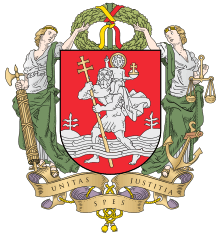
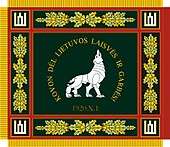

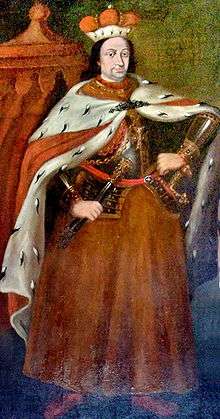

.jpg)
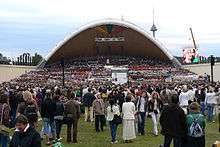
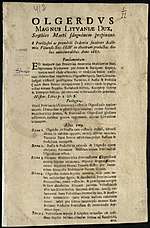
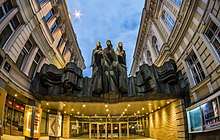
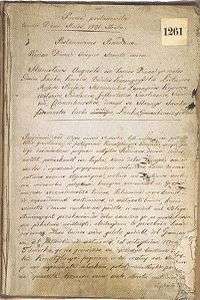
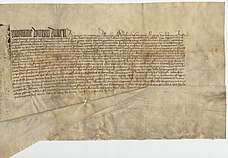


.jpg)
